This is a line of articles discussing a sailing trip from Lisbon in Portugal to Arrecife on Lanzarote. Six new yachts manufactured by Dufour of France had to be delivered to LAVA CHARTER, a charter-company with German roots operating from Arrecife. This fleet of six brand new Grandlarge sailing yachts ranging from 38 to 51 feet has been sailed by dedicated skippers well known to the company who recruited their respective crews amongst friends and commited sailors. I was offered the chance to be part of one of this crews, manning a Dufour Grandlarge 460.
I must admit that I am somehow a fan of Star Trek. And I remember that there is this very long, very special scene in both the original motion picture as well as in the so called “reboot”-remake by J. J. Abrams when Captain Kirk, through a shuttle window, first gets to see the USS ENTERPRISE with his own eyes. Minutes of cinematic worship for the curves and lines of the legendary spacegoing craft. Well, not exactly, but almost like these unforgettable minutes in cinema had been the long walk up the jetty in Lisbon after I arrived after a bumpy flight. There she was: My yacht.
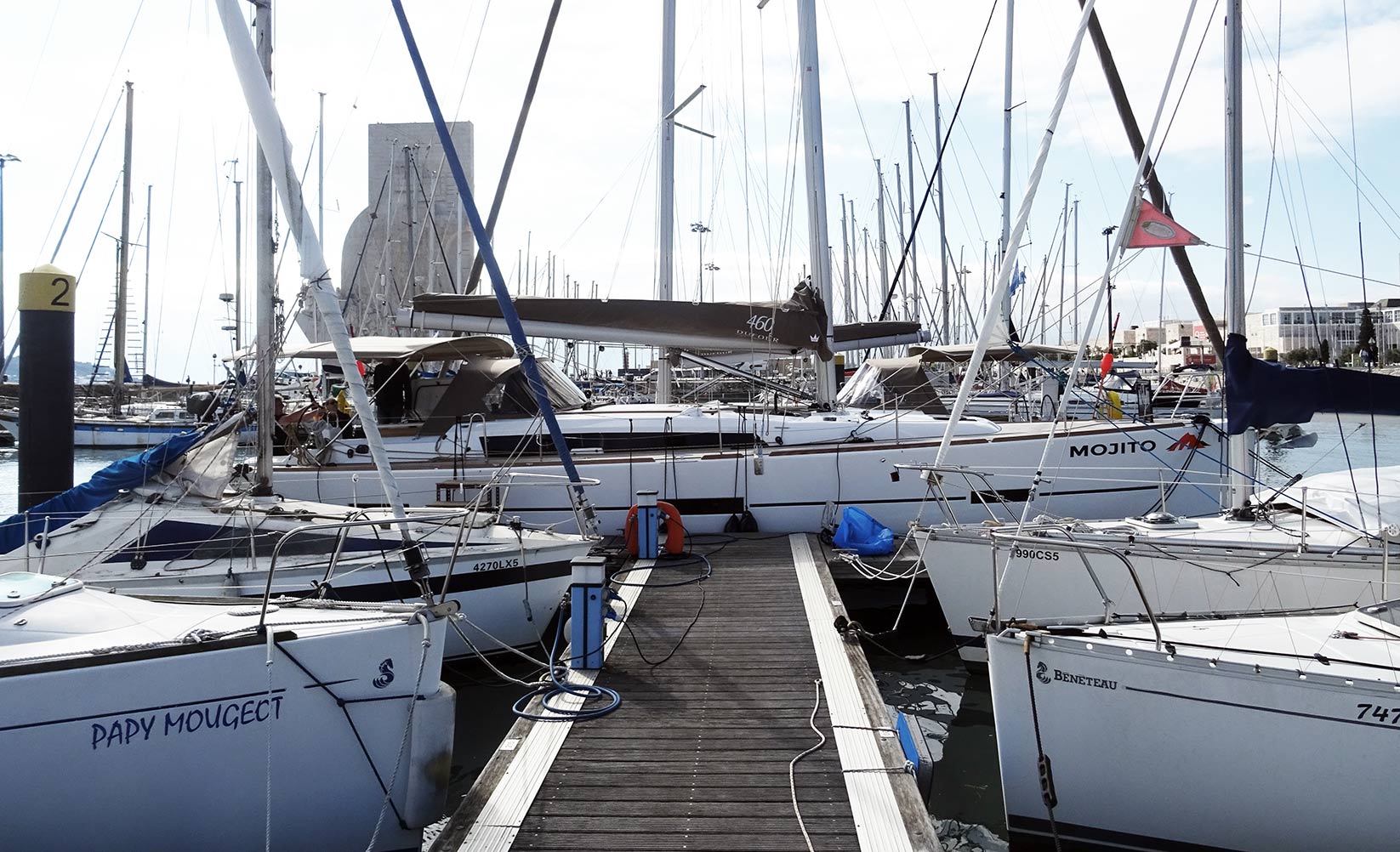
Not exactly my yacht in terms of possession, but my home and my working place for the coming two weeks. A brand new Dufour Grandlarge 460. She was tied to the head end of the jetty, slowly beginning to fill my whole field of vision. Her perfectly plain white hull, a nice raise in her sheerline, the flush deck with a flat cabin superstructure – trademark and signature of Umberto Felci-designs as he is creating the hulls for Dufour Yachts of La Rochelle in France. A total of 6 boats had been delivered by truck some two weeks ago. Since then, a whirling crew of LAVA CHARTER employees have been bristling around, rigging and equipping the yachts and readying them for their long maiden voyage. A truly long one: Some 850 miles down south along the African coast to the Canary Islands where these yachts will serve as charter boats for dedicated sailors.
Meeting Crew and Boat
I liked her lines from the first day I saw this yacht on the Boot boatshow in Dusseldorf. As Umberto Felci is a renown naval architect having done quite remarkable boats for both hard racing and performance as well as having worked for Italian boatbuilder Grand Soleil, his designs offer a promise of perfect seagoing character, speedy sailing abilities and that certain something. We are lucky as LAVA CHARTER had rigged the 460 with a large Genoa instead of the self-tacking jib and a full battened main sail instead of those awful furling mains.
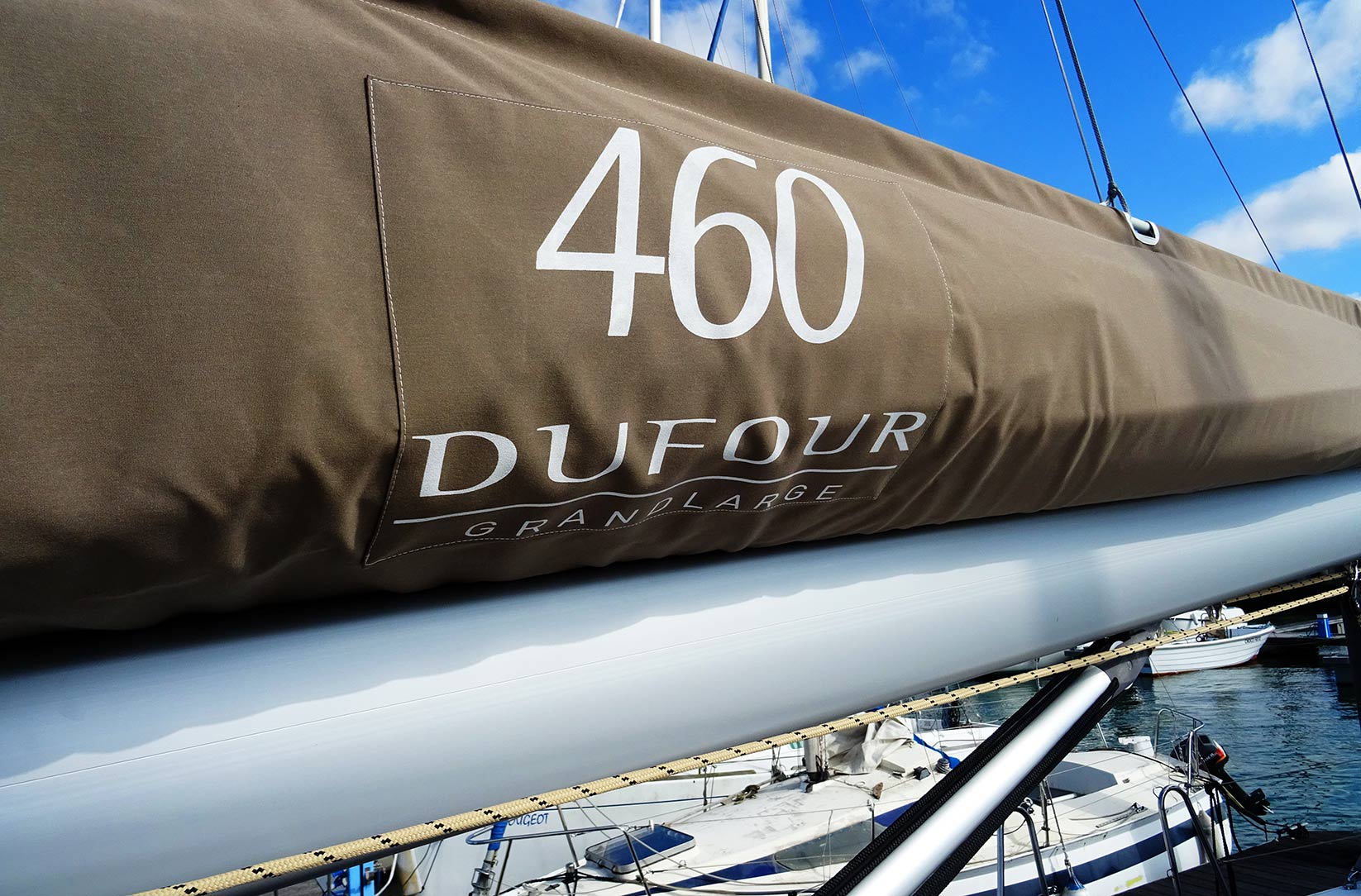
The Dufour Grandlarge is a 46 feet cruiser, measuring 14.15 metres overall length bearing a maximum beam of 4.50 somewhat shortly before her chined stern. She has the deep keel with a draft of 2.20 metres and is of course rated Cat A. LAVA CHARTER opted for the larger Volvo Penta engine with 75 hp, Diesel tank has a capacity of 250 litres, fresh water is filled in two tanks with a capacity of all in all 530 litres. With five people on board (and no showering, cooking with bottled mineral water) we managed to empty half of this fresh water capacity within 4 days. Finally, Genoa with 47 sqm and main with 53 sqm will create a total sail area of 100 sqm. More than enough to go fast, as we are going to experience on a daily basis soon.
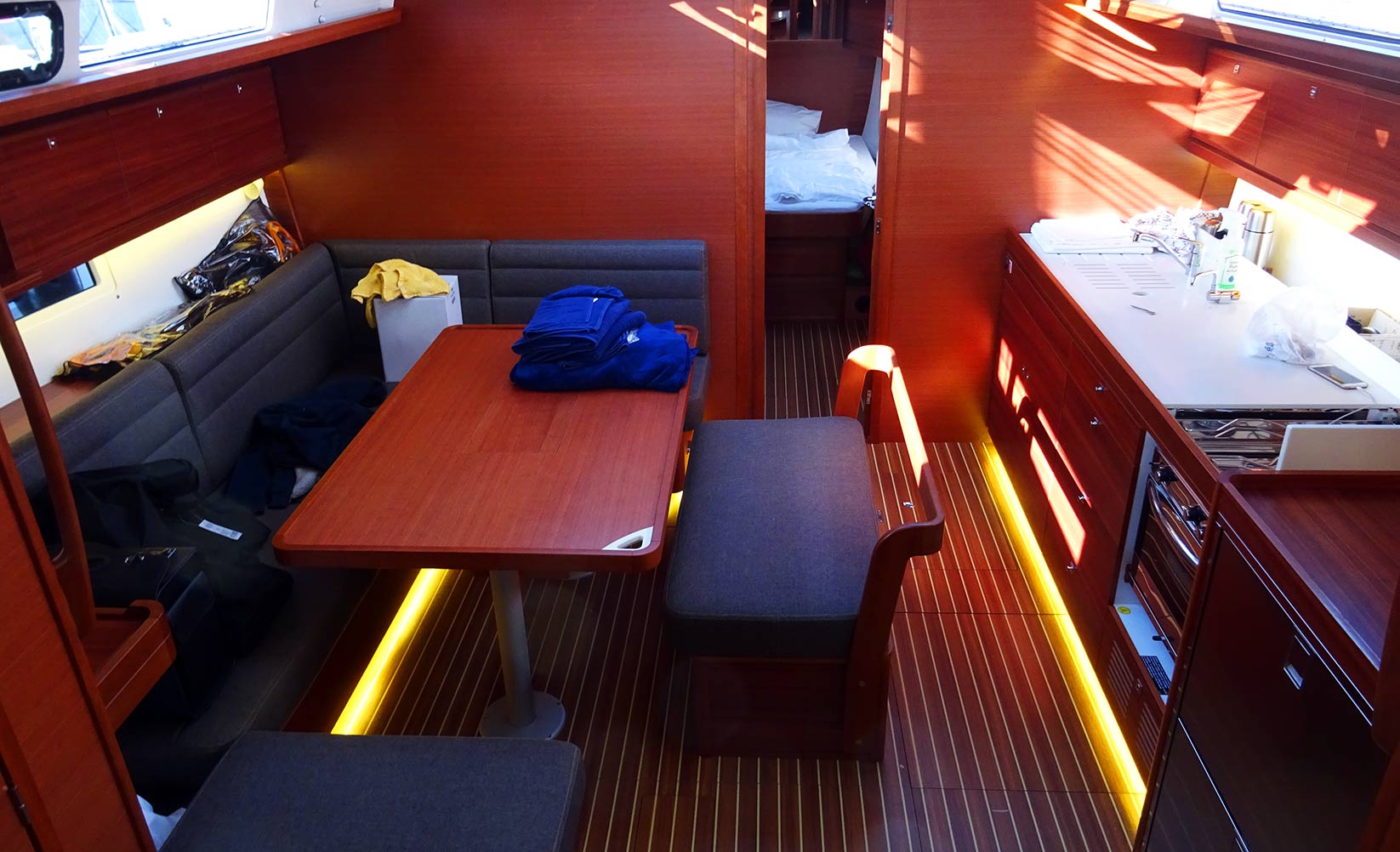
She is a cruiser made for a leisure cruise for sure. Her interior is both spacious and equipped with all amenities modern cruising families will ask for: Two very large fridges in restaurant quality, LED-lighting in numerous variations, spacious seating and large berths in three cabins. Although I like the 460 layout with the transverse galley more than this classic layout, she is a beautiful boat for sure. As I enter the yacht, I meet the crew of my yacht. First, there is Wilfried, the Skipper. A tried sailor, some 66 years old and from what I can judge – and will experience later on – he is an old salt. Wilfried introduces me to Thomas (a sailor as well) and Martin (who is a surfer guy since his childhood). All of them three already had done a similar voyage bringing a Bavaria yacht from Mallorca down to Arrecife. Ute, the woman on board, is a friend of Thomas. She is as inexperienced as one could be and looks forward to the trip.
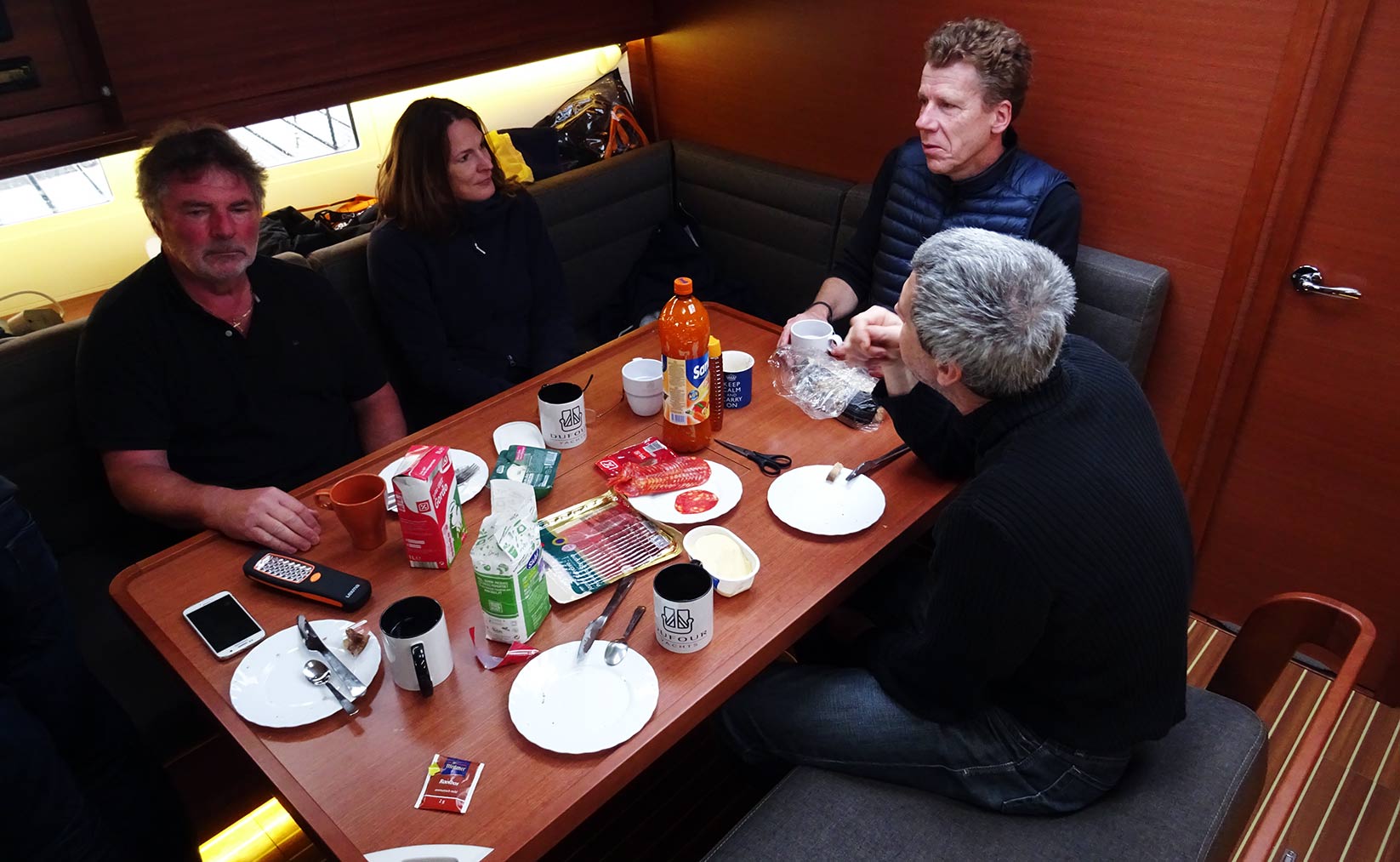
There is a warm welcome for me, the newcomer and minutes later I feel a part of this crew as we sit down in the saloon and get to know each other. But there isn´t much time to waste here as the LAVA CHARTER manager breathless arrives and advises us of the various items to be crossed off his list. We all agree that his job is not one to be envied: 2 weeks of meeting schedules, running around collecting the hundreds of parts for equipping the boats and fighting the smaller and bigger teething troubles on these brand new boats as they are experienced with certainly each and every newly delivered production yacht these days. We help as good as we can and manage to ready our boat right on the first day after some hours of stowing stuff, turning screws and unpacking equipment.
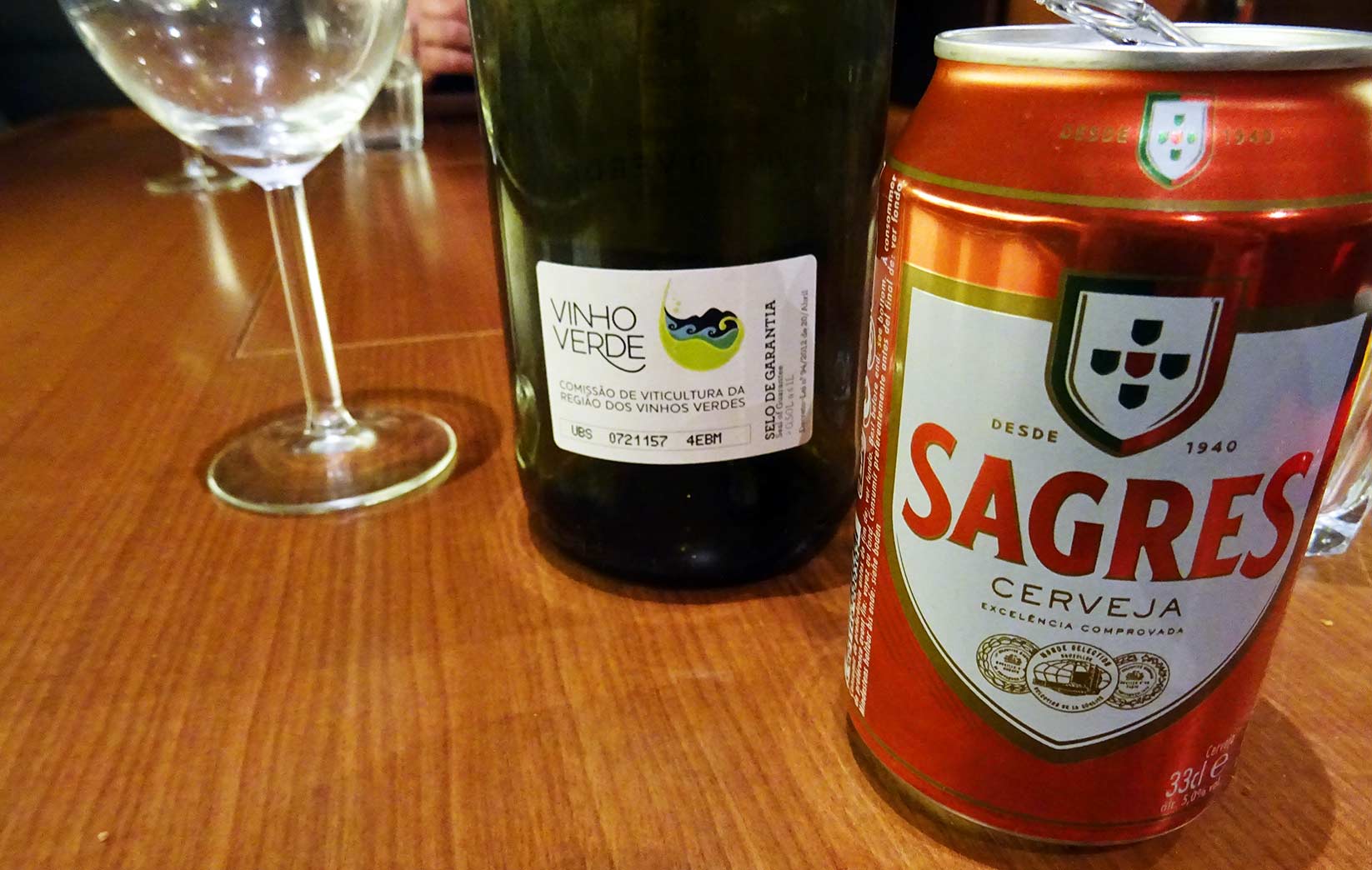
Later on in the evening we meet the crew of our sister ship with Sven, their respective Skipper. We stroll Alcantara, the borough of Lisbon where we moored our fleet, in search for a restaurant. Having some bottles of famous Portuguese Vinho Verde and Sagres beer we discuss the voyage, courses, weather conditions and whether or not landing in Africa is a choice. The Skippers have to leave Lisbon until March 4th as demurrage is paid until that very day and will have to deliver the boat latest on March 18th. As long as they are not going to risk the new boats, it´s up to the Skippers to decide Ports of Call along the trip. 14 days is a long time, much more than needed when going down straight, so it´s clear that we will have the chance to see some harbours along the road. I would love to see the Port of Rabat, but all Skippers agree that Africa is out of the question. Well – I´ll keep that one for later.
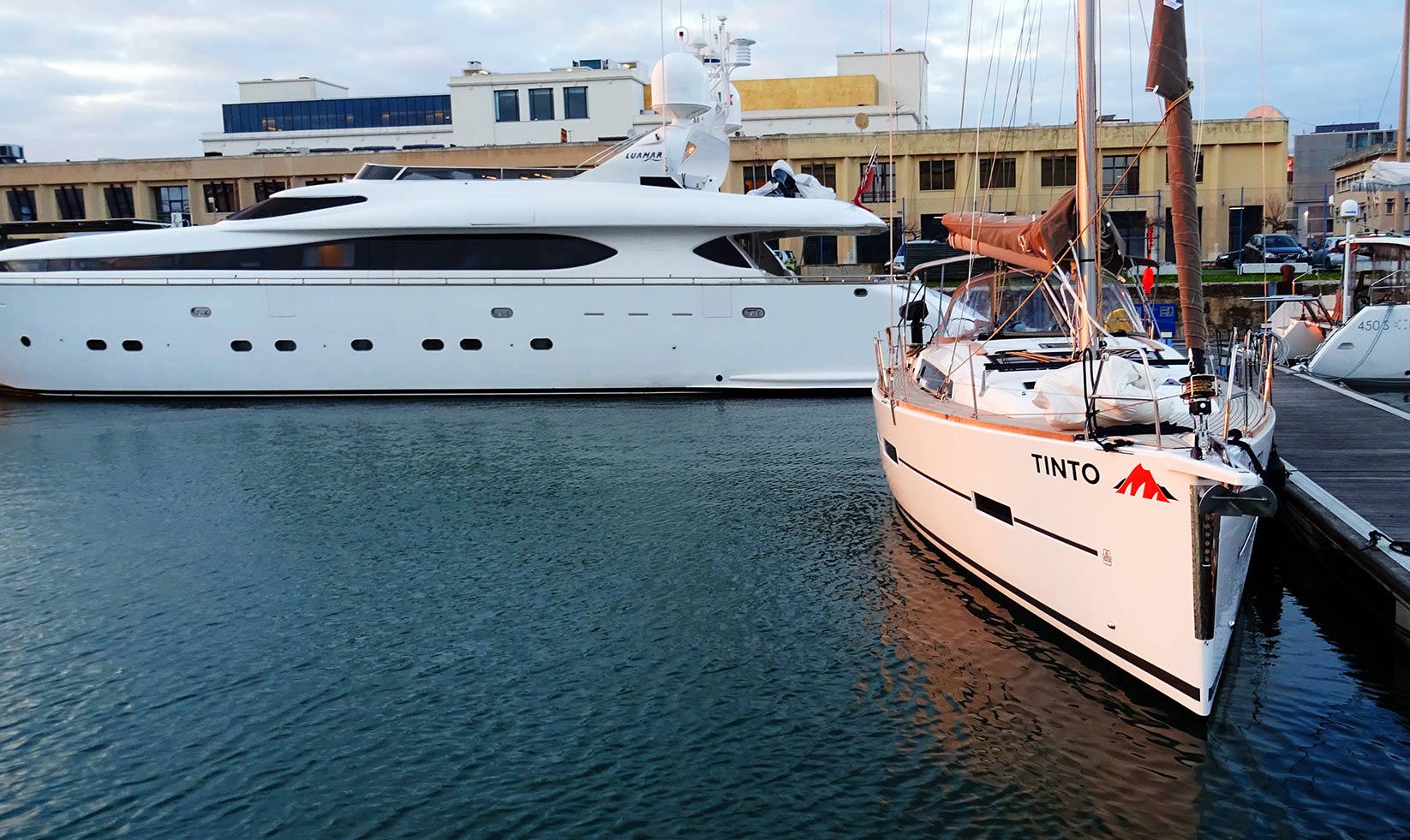
As we return to our boat the first day draws to an end. The crew enters their quarters. Ute – as the only woman of the crew – has been offered the exclusive use of the large owner´s cabin in the bow. I envy her large sized island bed, her electric WC and separate shower-cabin. But that will change later on. Thomas and Martin occupy the starboard aft cabin, Wilfried – as it is tradition on all yachts – will make the port side aft cabin his Skipper´s lodging. For myself, there is a makeshift seaberth on the large U-settee in the saloon, which I pretty much will learn to adore during the trip. I apply the ear-plugs, close my eyes and enjoy the gentle see-saw of our tied up boat and the fresh salty air entering the saloon as I dream myself away.
Getting Ready for the Ride: Provisioning the Yacht
Sailing the Atlantic Ocean on an 850 mile long trip is a long one. Especially if five people want to eat three meals daily. Next day after breakfast we clean the saloon and I take out pencil and paper: “Let´s make a plan what to buy for the trip.” We sit together and begin to write down a long and longer list. “Sugar?” „Yes, but I´ll need artificial sweetener.“ „Onions?“ „I can´t eat onions.“ „Coffee?“ Yeah, but I´ll prefer Earl Grey tea.“ „Peppermint tea for me please!“ It´s a total mess. How does the ship´s cook manage to meet all the individual preferences and no-gos of the crew? At last I am lucky that we do not have a vegetarian among our fellow crew. Two of us board a bus rented by all the boat´s crews heading for a large shopping mall.
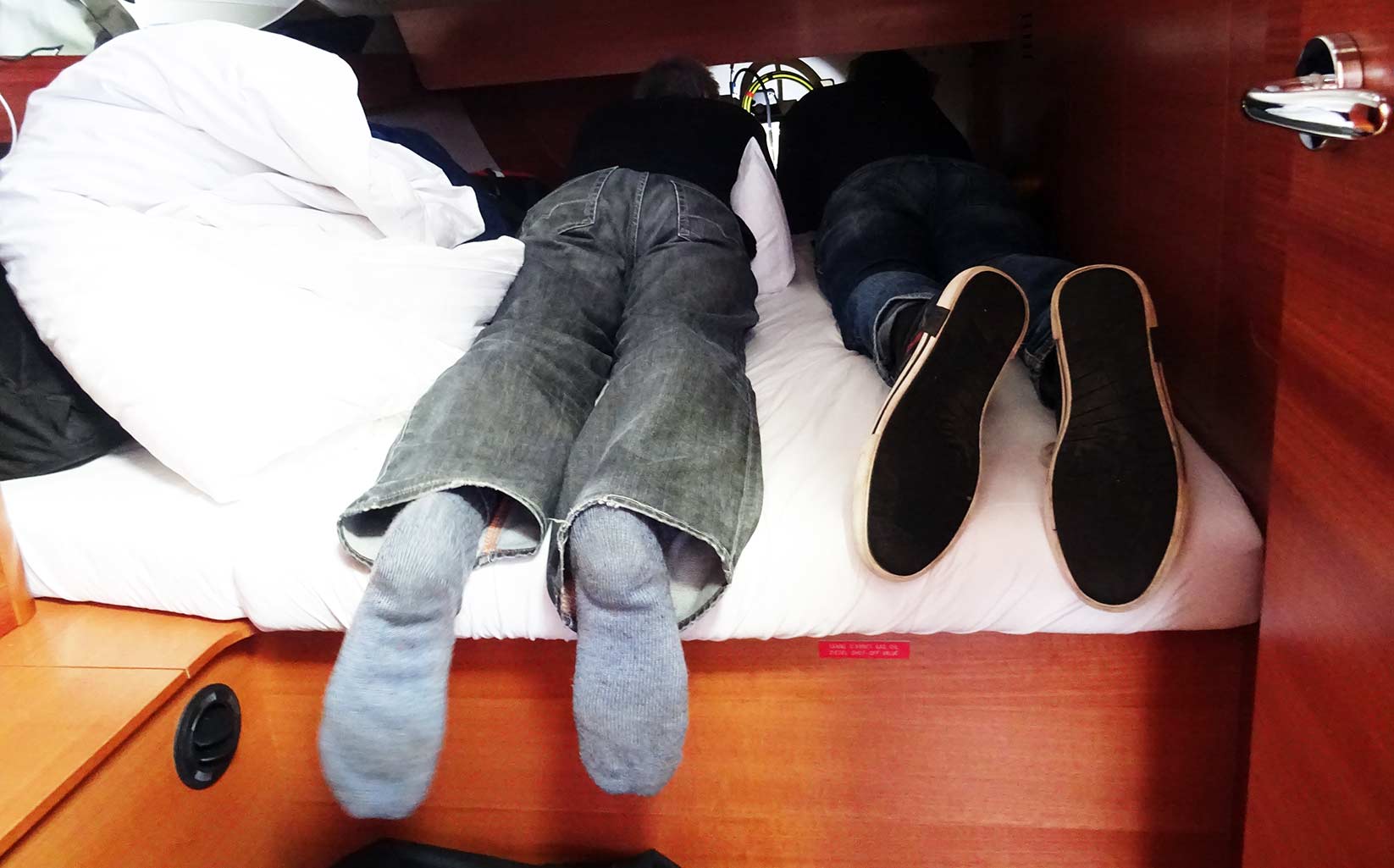
Thomas and I remain at Doca di Alcantara to help with the last work needed to be done. A Raymarine official arrives to calibrate GPS, plotter and selfsteering systems. That´s a very interesting process if it wasn´t for some bad thunderstorms bringing falling temperatures and heavy rain to Lisbon. I take out the oilskin and brace myself in warm clothing: Not one single mile out on the Atlantic Ocean but yet packed in heavy weather gear. After some two hours all boats are cleared for the voyage. I inspect the running rigging of our yacht. And I stumble: “What the hell is this?”, I ask Thomas. It was the German Cupper Mainsheet System. Never seen this in real life. Both main sheet and jib sheets and on the aft winches. In a tack one will have to operate the sheets in the back of the helmsman, locking the mainsheet on a clamp. “Impractical!”, I judge and consult the Skippers. All shake their heads: “Let´s re-install the classic mainsheet and relocate one sheet to the starboard winch on the cabin roof near the entryway.” This is where the mainsheet belongs. And behold: There´s an electric winch installed.
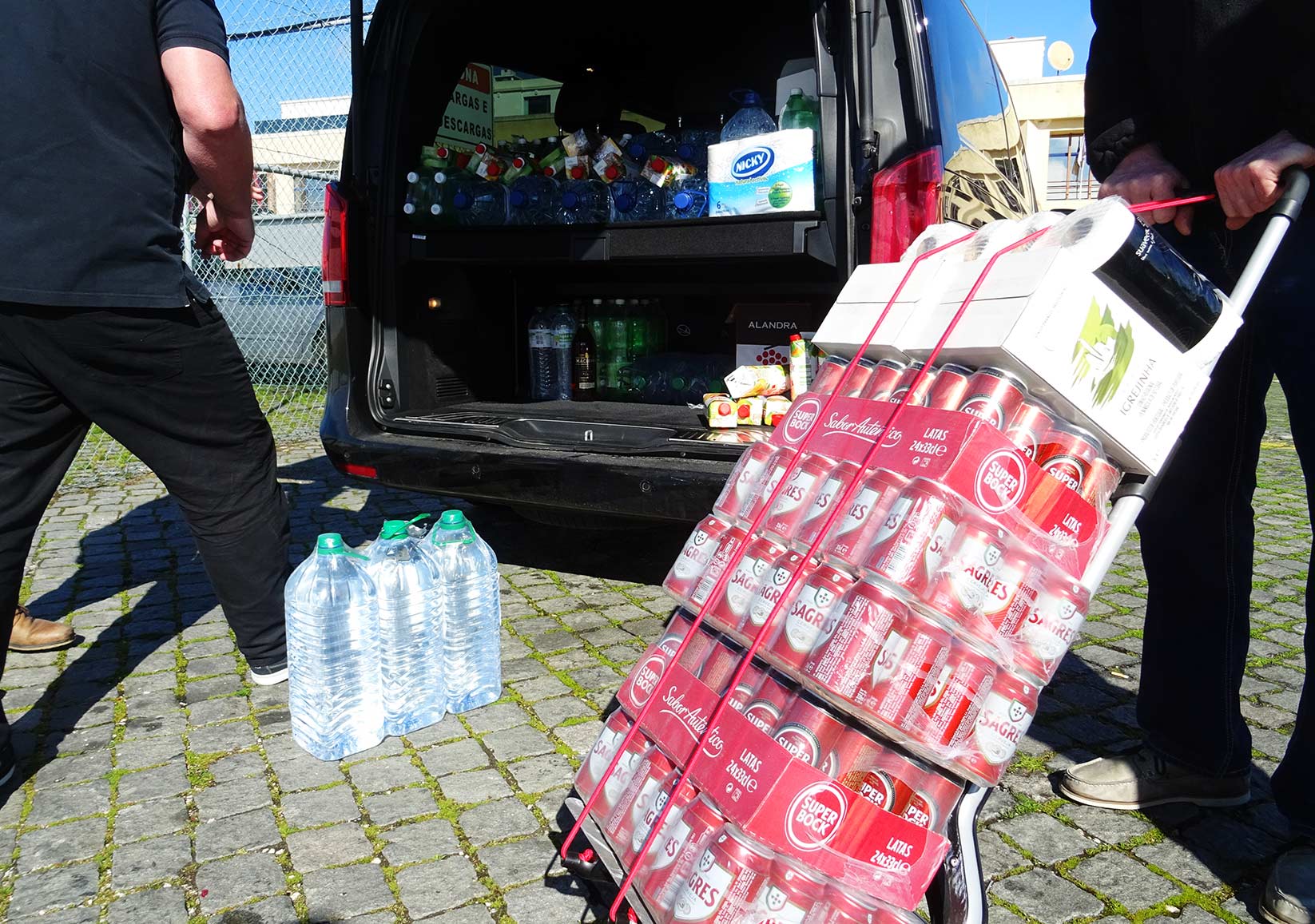
Martin and Ute arrive from their shopping trip, seemingly exhausted. As they open the trunk, I stumble: On the upper stowage there´s tons of water, juice, fresh vegetables, bags full of apples, zucchini and all that fine stuff. “That´s the provisioning for our boat”, Martin says with a smile and points to the lower stowage: “This is for our sister ship.” Palettes of beer, boxes of wine, bottles of hard liquor are pulled out of the crew. I favor our choice.
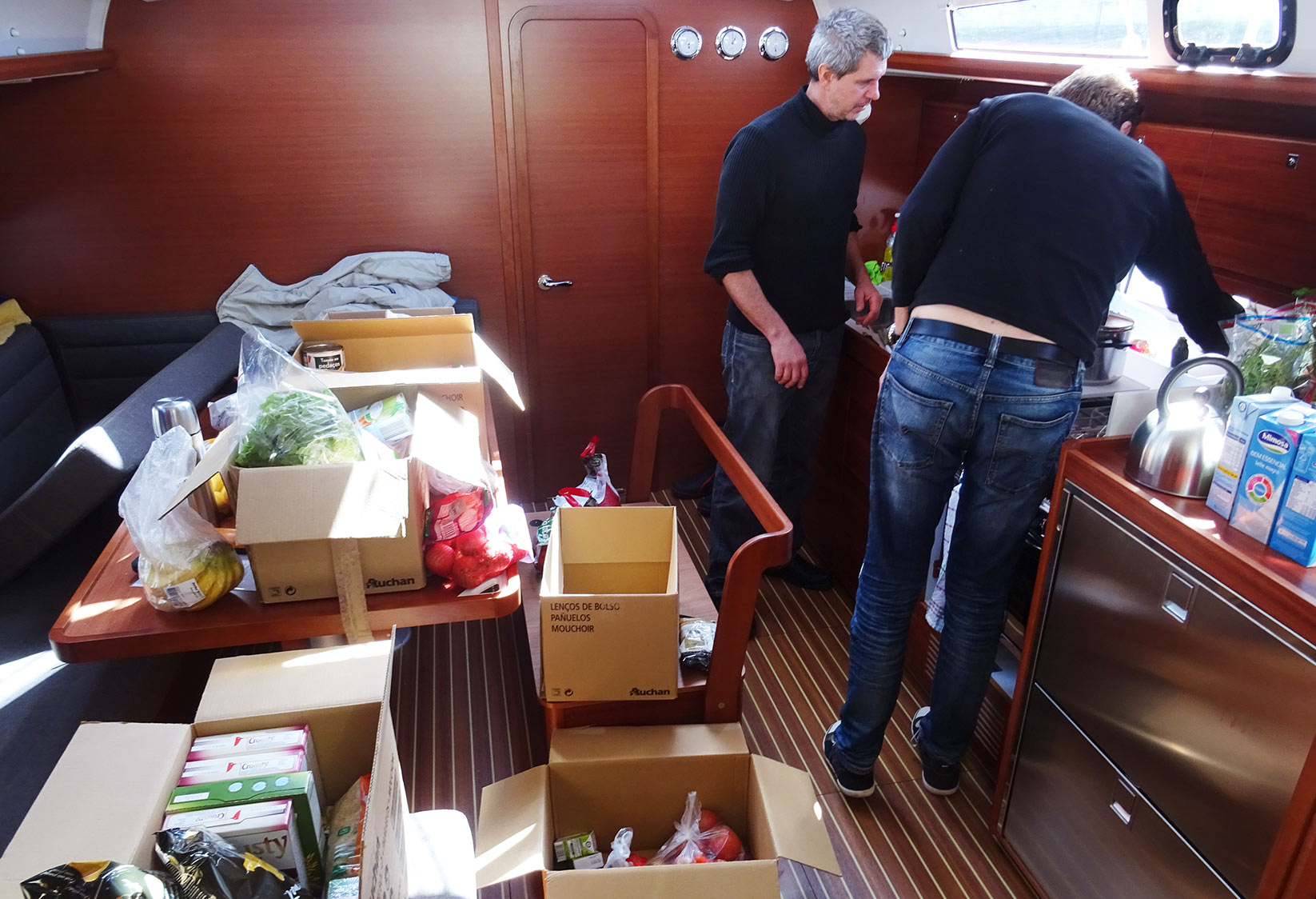
As we have carried the uncountable bags of food and drinks to the boat and brought them down below deck, we begin to stuff all possible and even the impossible angles and corners of the yacht. As the lockers are already occupied by plates and stuff, we find the deep bilge very spacious to house the bottled water: 70 litres of non-sparkling and sparkling water, half a dozen Coke Zero, litres of apple juice and tonic water. Fresh potatoes and onions (10 and 5 kilograms) along with a dozen or so variants of pasta and rice (parboiled and Basmati-style) are stowed in the central stool placed on top of the keel. Cans and glasses of cornichons, mashed tomatoes and sweet corn in the lowest lockers, meat, sausage, 40 eggs, bacon, 3 butter churns and alike are stowed in the fridges, fast filled to their top. It took a full day to ready the ship with provisions – never had thought it would be this exhausting.
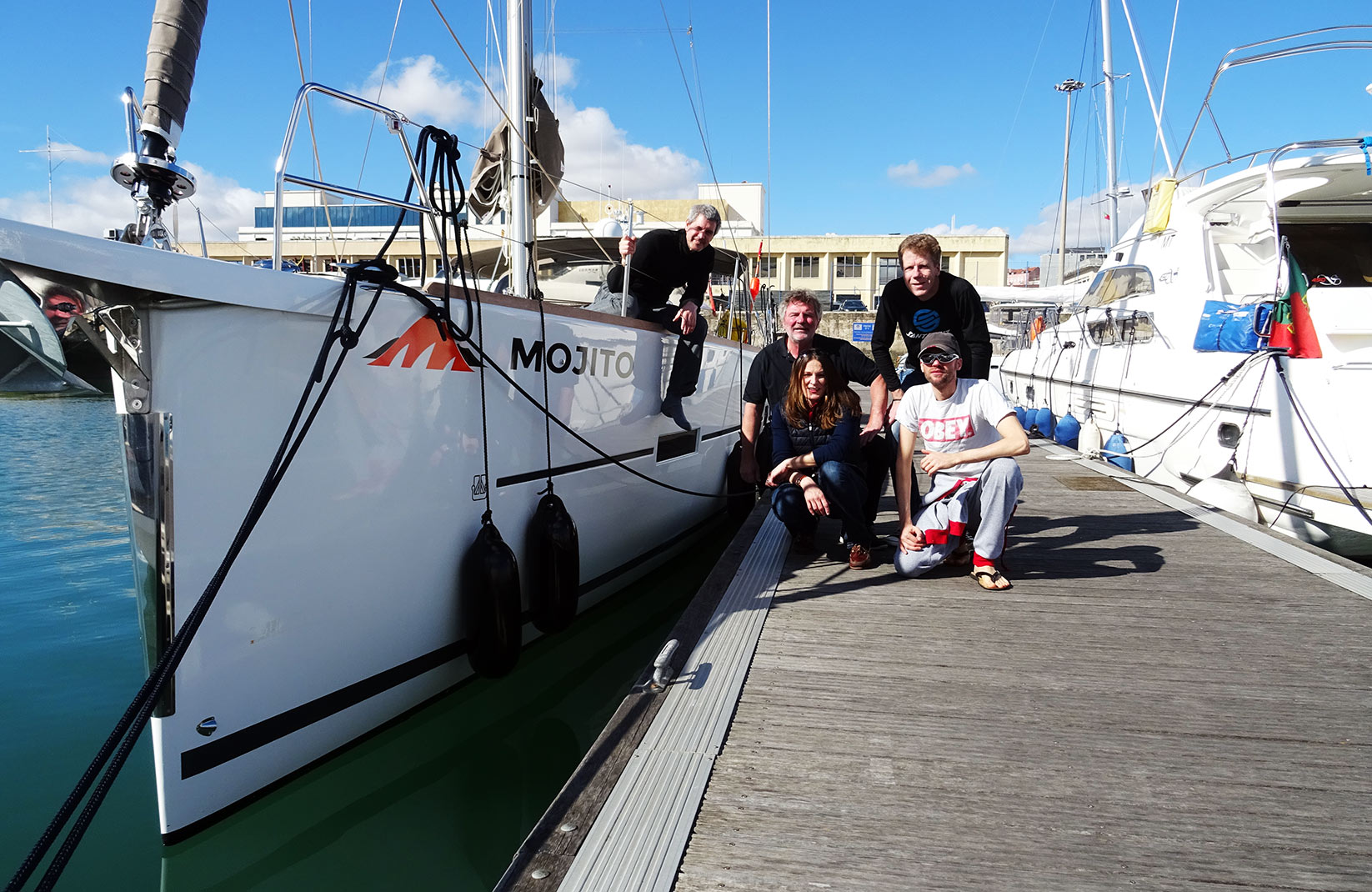
We spend this evening together and I cook a dinner for the crew aboard. We drink the last beers, empty a bottle of wine and Wilfried does a briefing on the trip. Before sunset we shoot the starting picture of our crew: See that excitement and the joy in our faces? We are going to enter the Atlantic Ocean tomorrow, set off for a long voyage to the Canary Islands. This is what a happy sailor´s face looks like. Ute had this nice idea: As our yacht bears the name SY MOJITO, we after all have a bootle of hard stuff aboard as well. “We´ll open this one, ice cold, upon arrival at Lanzarote”, she promises and we all agree.
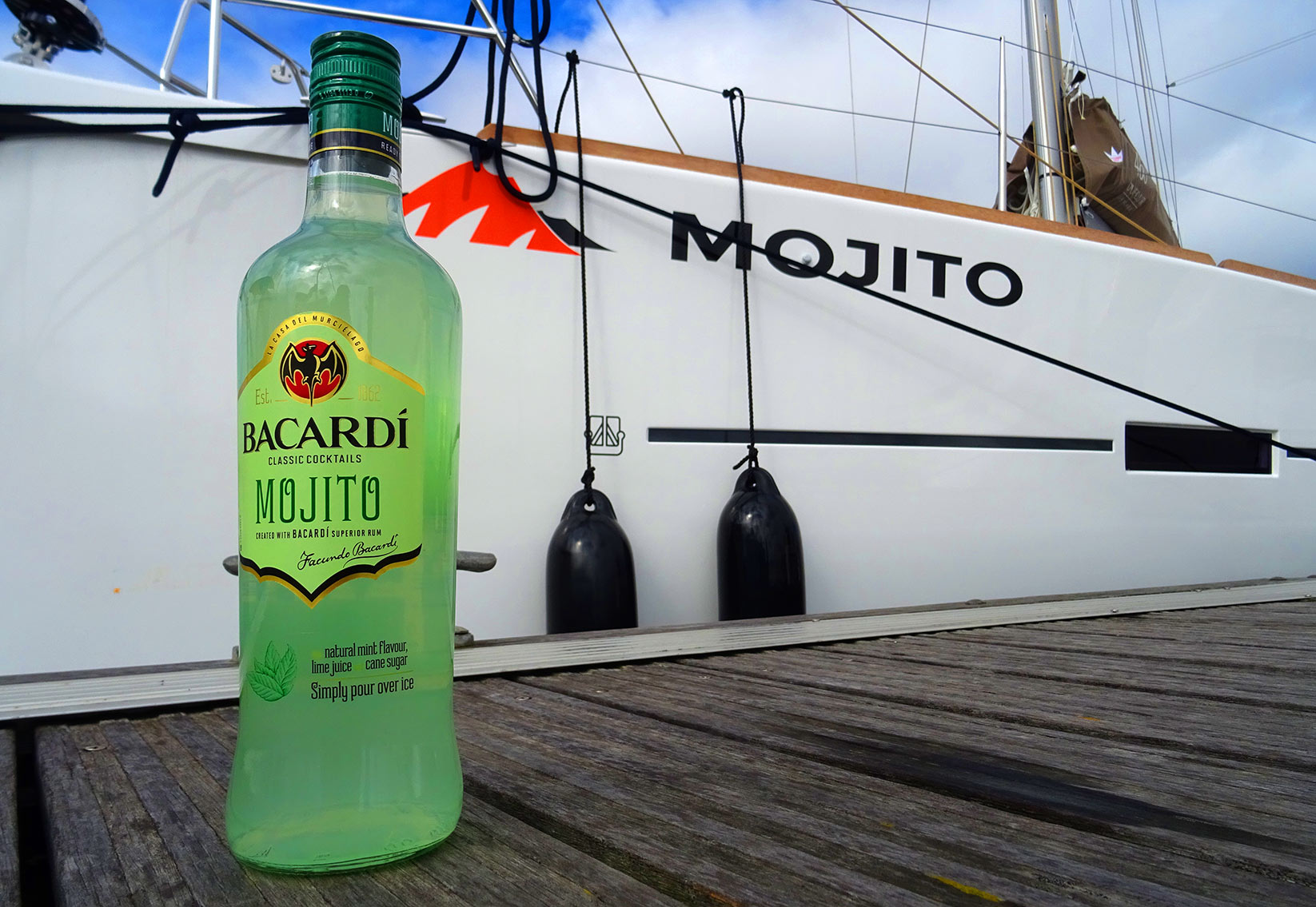
My second night aboard SY MOJITO and I am readily accostumed to my somewhat unusual berth in the saloon. I don´t envy the others in their cabins: Of course, Ute in the bow has the most roomy cabin and her own private head, but she will get the most of the ship´s motions when underway. In headwind, sleeping will be a tricky task for her. Thomas and Martin have to share one aft cabin: Heavy snoring right next to one´s ears? A lot of condensation in that small room, no matter how big their cabin is – my saloon is far bigger. I have the freshest air, don´t have to sleep next to the engine, the selfsteering motor and nobody will clump on my head. Casting off is set for 12 o´clock tomorrow. I can´t sleep a minute tonight.
Finally: Casting off to the Canary Islands
I awake by the noise of a laving boat. Quickly peeling myself out of the warm sleeping bag – it´s cold and rainy outside – I see one of the Dufour 412 casting off. It´s the SY TINTO leaving her berth right after us. I turn around to look for the other boats: The Dufour 382 SY TORTUGA had already left earlier this morning as well as SY DON CAMINO, the big flagship. SY CAMINO, the other Grandlarge 412, is still tied up and our sister ship SY AVATAR is also mooring. We enjoy a rich breakfast with scrambled eggs, sausages and roasted white bread with cheese, some cups of coffee and warm talk. On Channel 16 SY AVATAR calls us, urging for casting off.
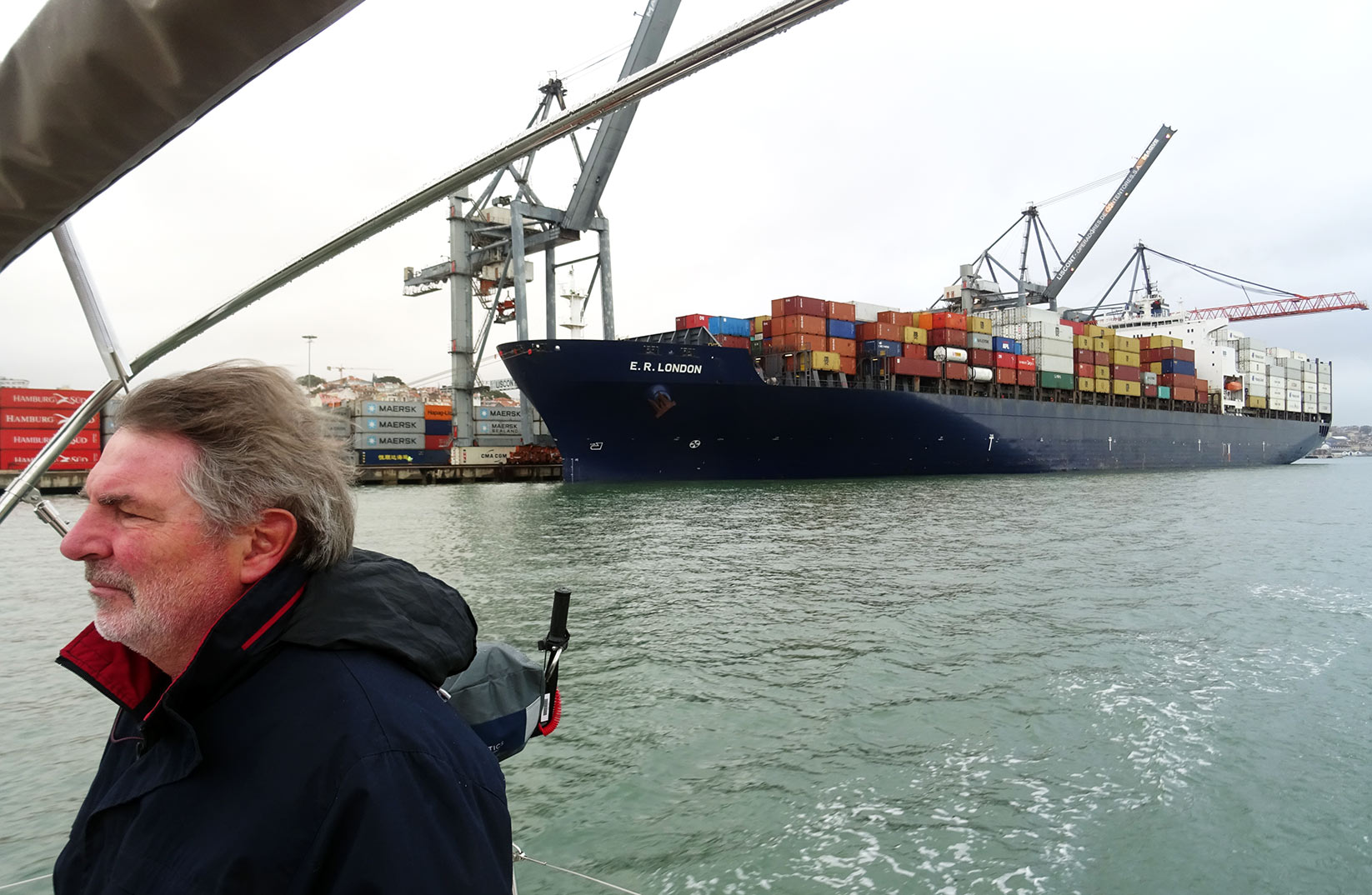
I wear two layers of warm clothing and the full heavy weather gear as we drop the lines, take in the fenders and head for the San Francisco-like Ponte 25 de Abril. It´s a long, smooth wave pattern as we steam downriver Tejo to the open sea. Passing the commercial docks and Torre de Belem, I take the helm and keep our boat in the buoyed waterway: There is a shallow only 70 centimetres deep near Trafaria on the South end side of Lisbon which we must avoid. SY AVATAR is coming broadside and we exchange the last spoken words for days from face to face. From now on, we will see them only as blimps on the plotter, hear the voices on VHF and – of course – will try to keep them in a comfortable distance. Sailing faster than them is a question of honour and an unspoken friendly rivalry.
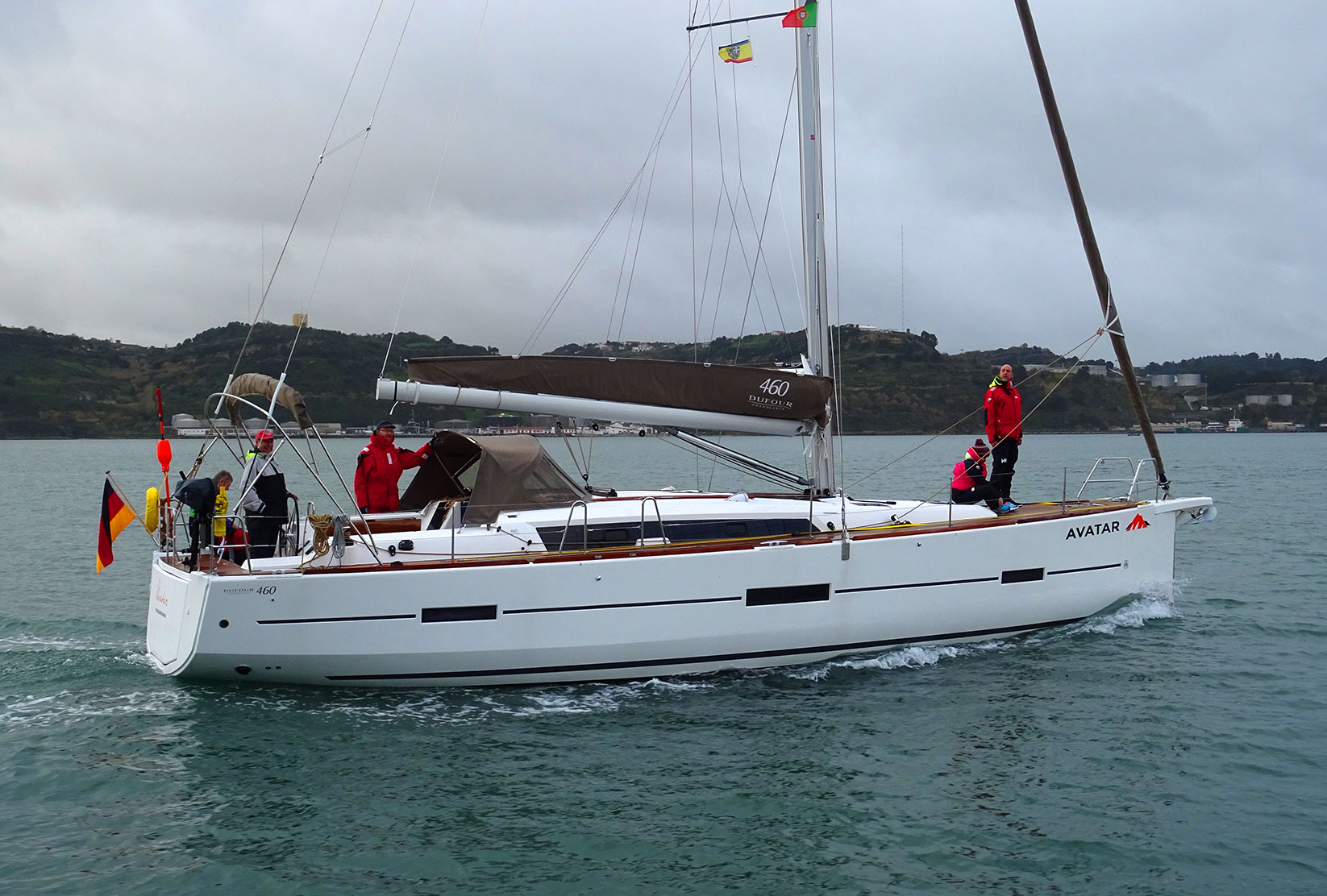
As we finally clear Forte de S. Lorenco de Cabeca Seca, the last landmark of Lisbon, Skipper tells me to turn the boat due 220 degrees – nearly exactly South-Southwestern heading to Madeira, our first harbour. As I do, I have to put the ship alingning the waves which from now on start to hit the hull broadside. Suddenly the swell changes from the long, smooth pattern to a quickly heightening sea of 2.50 metres to 3 metres in height with very short amplitudes. No good for my stomach!
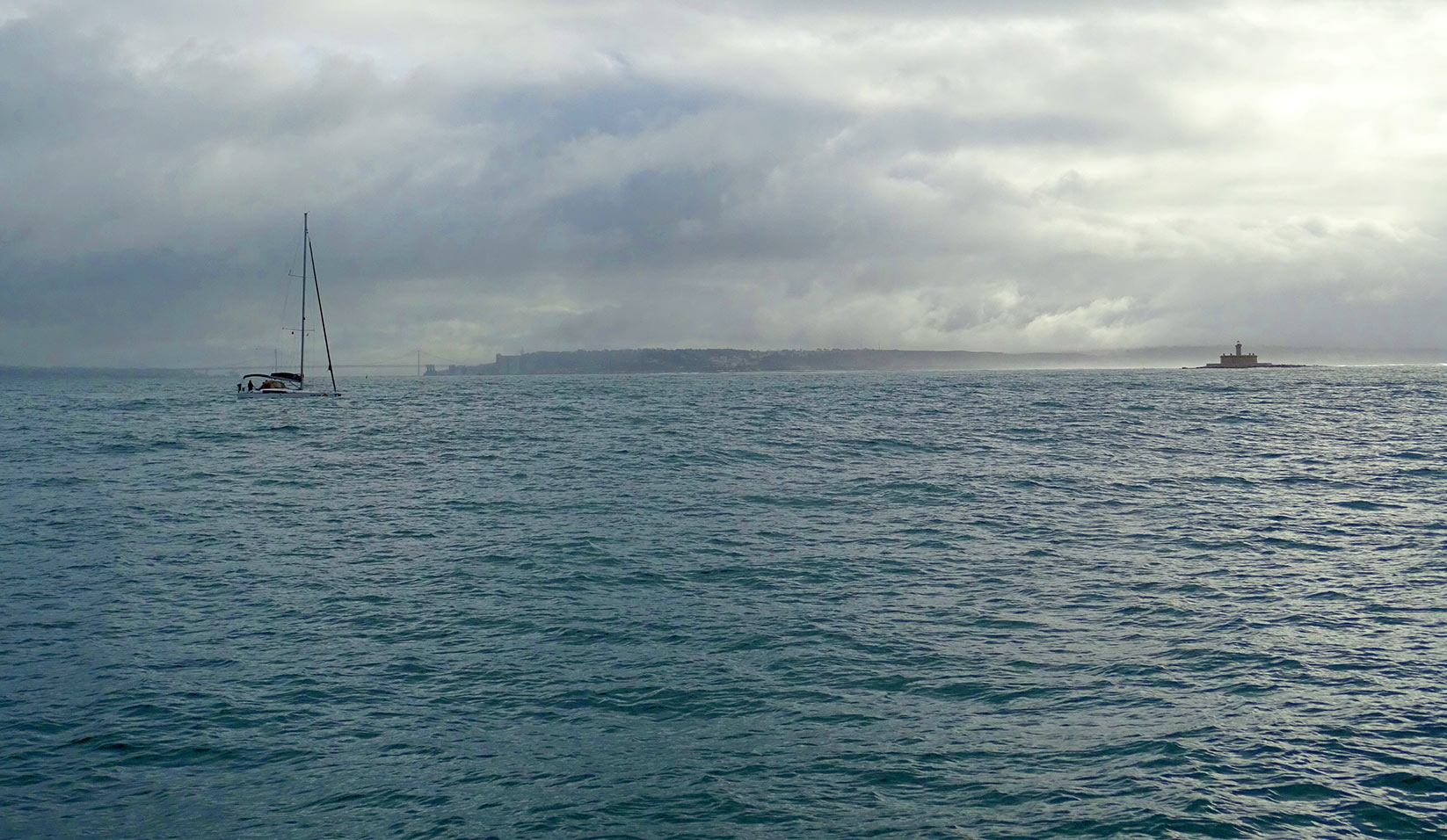
As I look at these pictures now I can´t believe my eyes as nothing of these waves is visible here. All along the voyage, even later in the trip when we´ve got these huge mountains of sea rolling up to our stern building to heights of 6 or 7 metres my camera won´t catch the amount of water nor the foamy wave crests. Unbelievable. But believe me: SY MOJITO quickly became embroiled in a furious short but high wave pattern making free standing aboard impossible. Lucky us that we opened the lazy bags of the main sail while still moored and nobody had to enter the cabin roof to reach for the zipper!
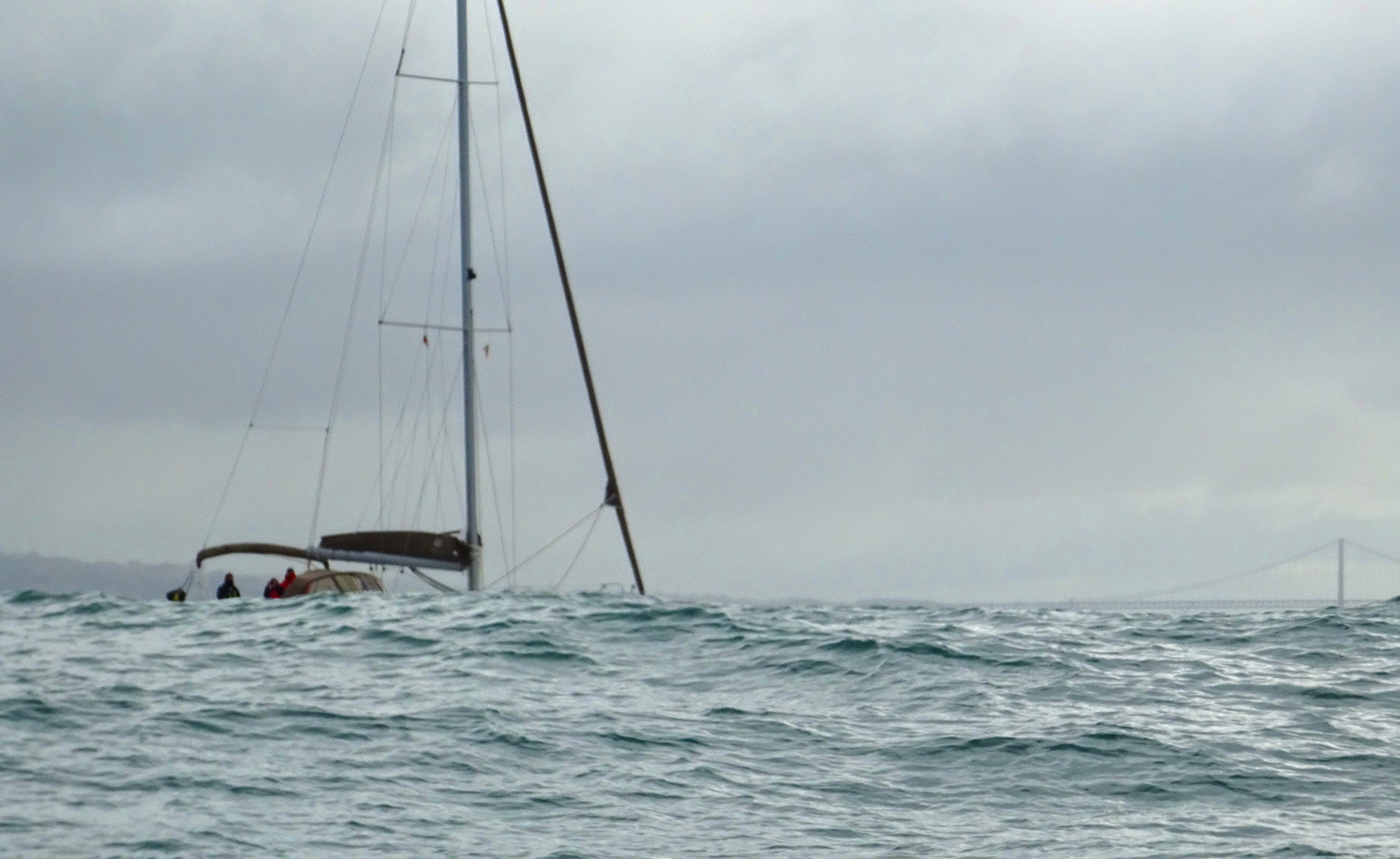
Although my camera blurs the waves to a homogeneous almost peaceful appearing blue area, our boats were shaking rough as we raised the main sail. Lucky us again, LAVA CHARTER did install an electric winch so nobody would had to go forward to the mastshoe and pull the halyard. After one minute of effortless pressing a button and applying some turns with the winch crank for the last centimetres we´ve had our main sail up and standing. A minute later the Genoa was out and wind filled the canvas. What a treat to shut down the engine!
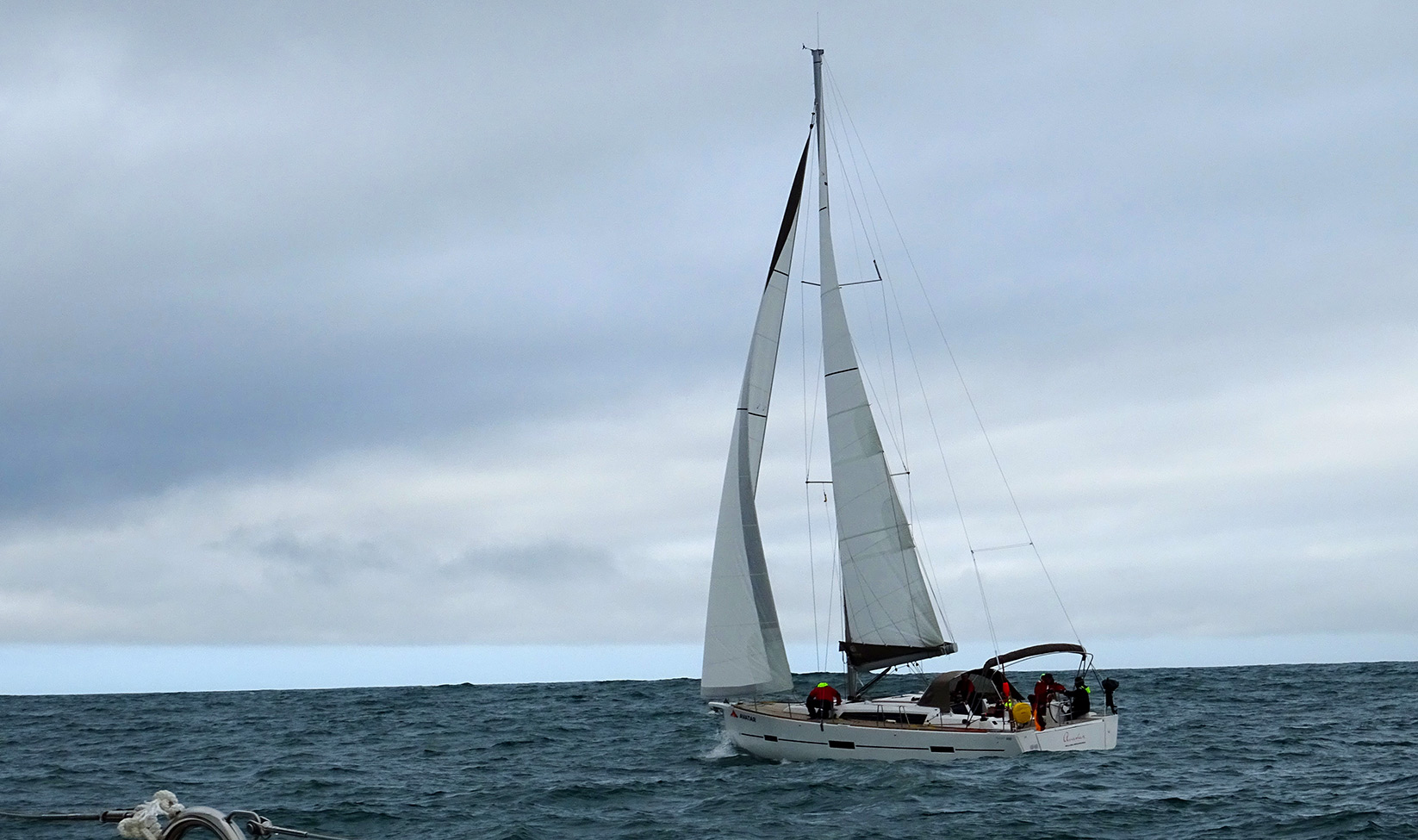
SY AVATAR bears a slight lead of two or three ship lengths but apparently we had been faster in trimming the sails, adjusting their angle to a beam reach, opening the sails further after clearing Cabo Espichel to broad reach. Overtaking our sister ship made us all smile although I turned pale evermore, all along our Skipper who also couldn´t bear these short-high seas.
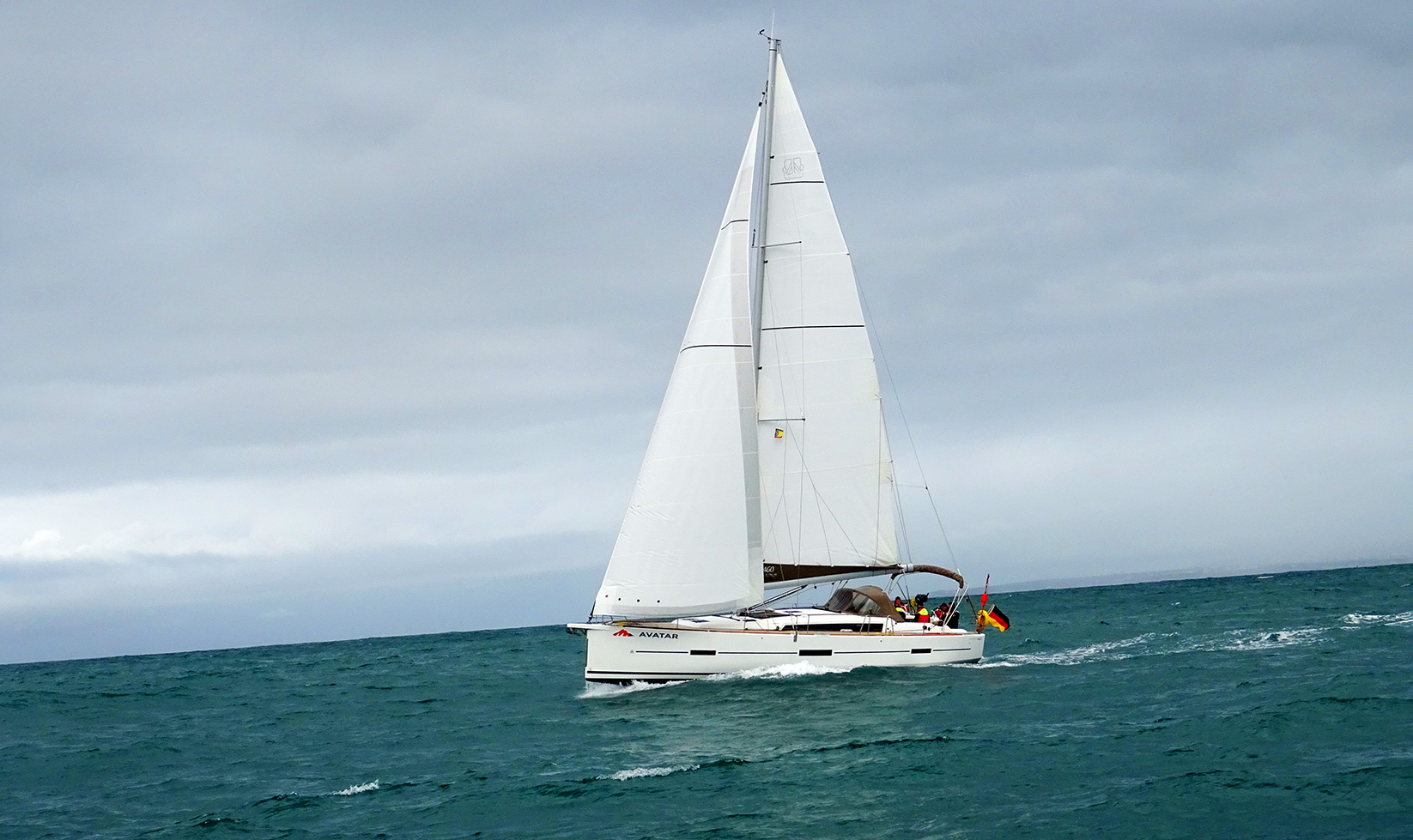
“She is sailing well”, we judged and adjusted the hauling point of the Genoa. SY MOJITO is sprinting downwind with a steady +7 knots pace. Her hull clearing the rolling waves perfectly although this ride is making my stomach sick. I don´t want to puke neither I want to leave the cockpit – now, that we are sailing. But I don´t want to risk anything and stumble down the entryway into the saloon. Lacking the sight of the horizon, my stomach suddenly turns upside down creating a bad, bad feeling in my guts. I literally throw off live vest and oilskin and jump to my shaking berth – upon laying down horizontally all symptoms vanish. No puking, that´s a good message at last. Five minutes later the Skipper skeltered down below deck, mumbling something like “… never happened in 40 years of sailing …” and also jumps to his berth. His face as green as mine. Welcome, Atlantic Ocean!
Seasickness has us.
Oh boy, that was awful! I did read a lot about getting seasick, possible prophylaxis and cures but as it struck me – it did really struck me. I didn´t puke, which I considered an advantage over Skipper Wilfried, who met the toilet a couple of times. I just jumped to my berth, laid down and closed my eyes – things improved considerably at an instance.
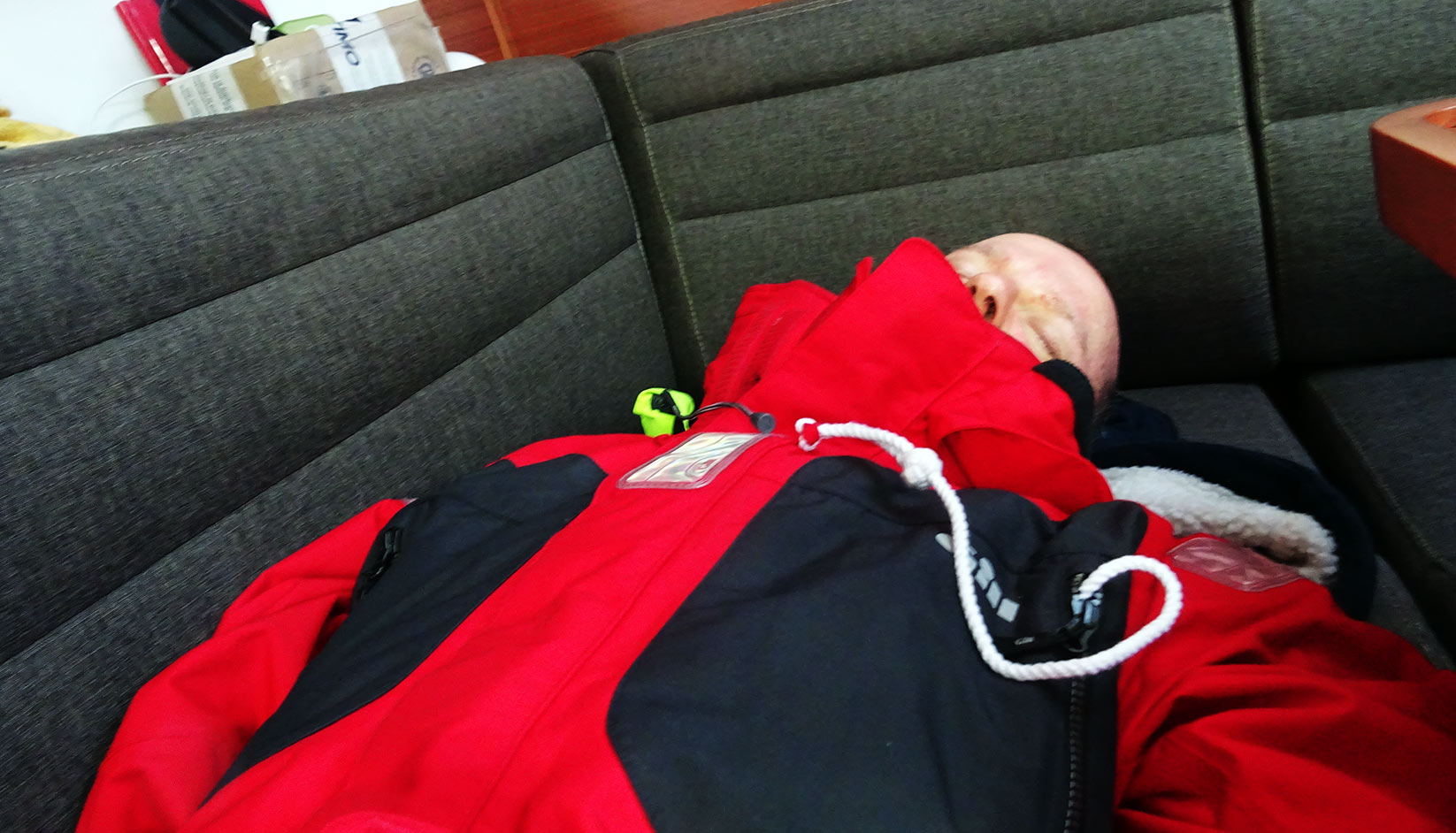
Some minutes later Ute came down as well. She fought her seasickness a little bit longer but nodded into my direction, pointing to her cabin and disappeared behind her door. She tried to get to sleep in hope for overnight cure. So, SY MOJITO had a 50% crew failure due to sea sickness right on the first day, on the other five boats this quota didn´t change much as I learned later.
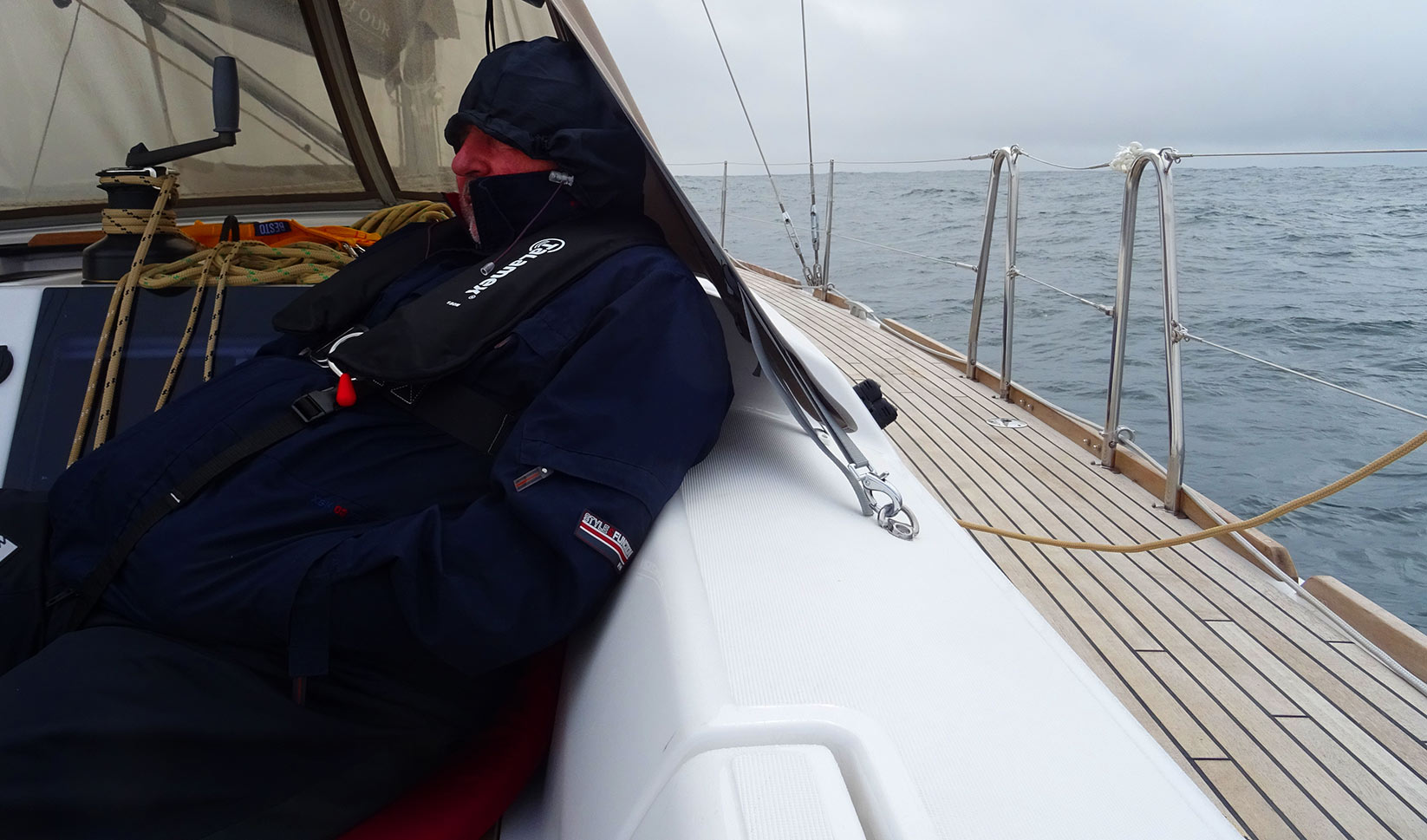
Nevertheless I still had my watches to perform. Hoping that things would improve once I could see the steady horizon again and being abstracted from being seasick by the task of a watch captain. It worked pretty well – for me. As I was sharing my watches with Wilfried, I could easily spot his uneasiness with the whole situation: Poor Skipper cramped himself under the sprayhood, pulled down his oilskin and hat deep into his face and rarely spoke a word. The feeling of dizziness disappeared virtually completely during my first watches but this awkward sensation in my stomach – “five to puke”, as I called it – remained to cause a very unpleasant overall condition. I couldn´t eat a thing other than one or two apples. I forced myself to drink bottled water regularly and hoped to replenish my body at least a bit. Four hours of watch went by … not so fast as I hoped.
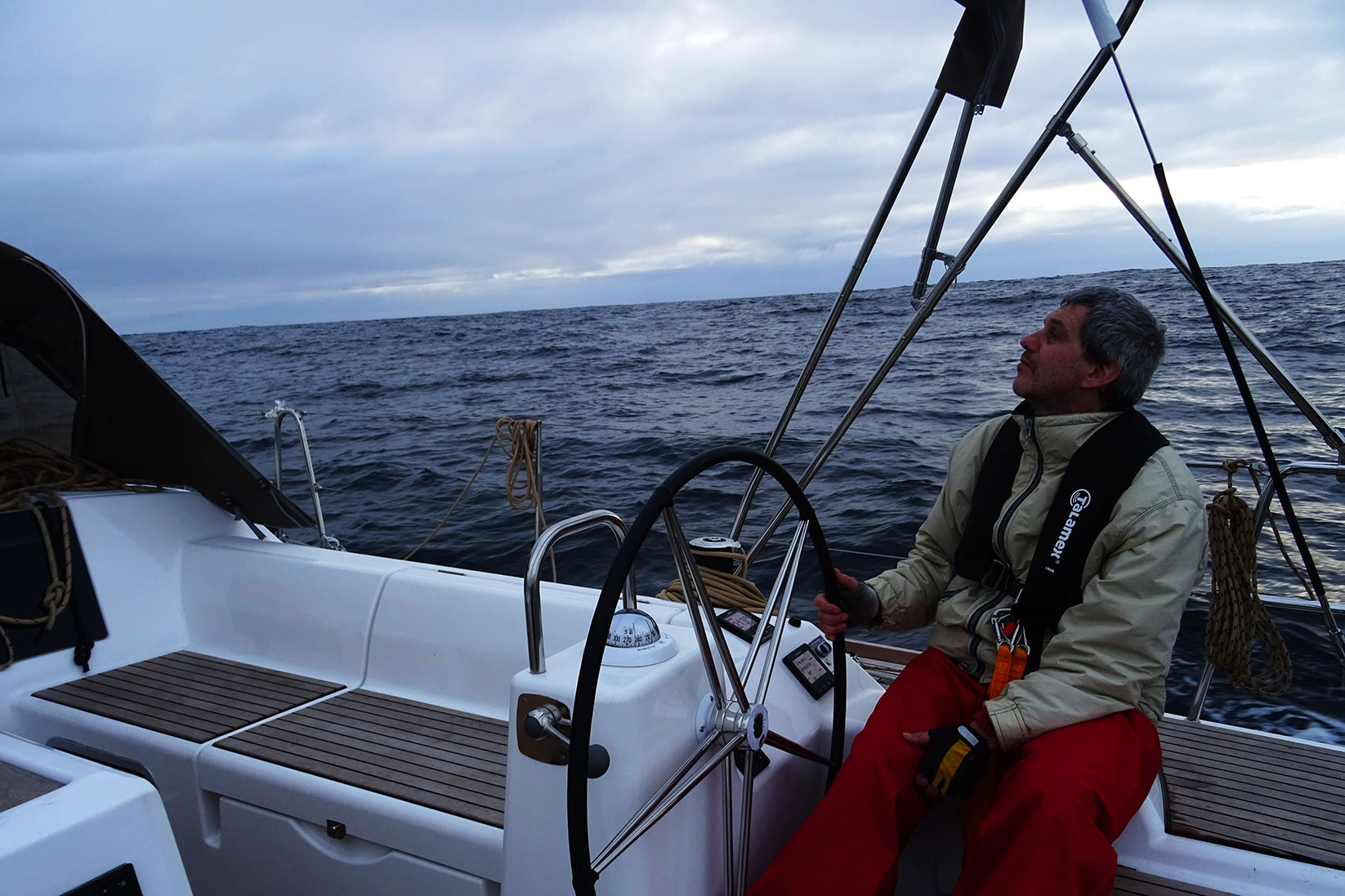
Others seemed tob e unaffected by the constant violent shaking of our yacht. Martin, a guy who is on the surfing board since he was 13 years old, never showed any symptoms. “I really thought it would hit me”, he once confessed to me: “As it always hits me. But I am perfectly fine here aboard. Well, besides being up downstairs too long, then my stomach starts to cry for help as well. Cooking is a mess for me.” Oh yes, cooking. As I was down the second day and wasn´t really able to contribute to normal life aboard the way I wished I forced myself up and prepared a proper hot lunch for the whole crew. Wedged between stove and stool I whittled veggies, sliced meat and cooked a threepart luncheon which was echoed by great applause. As the crew ate, I had to lay down again, anorexic and exhausted.
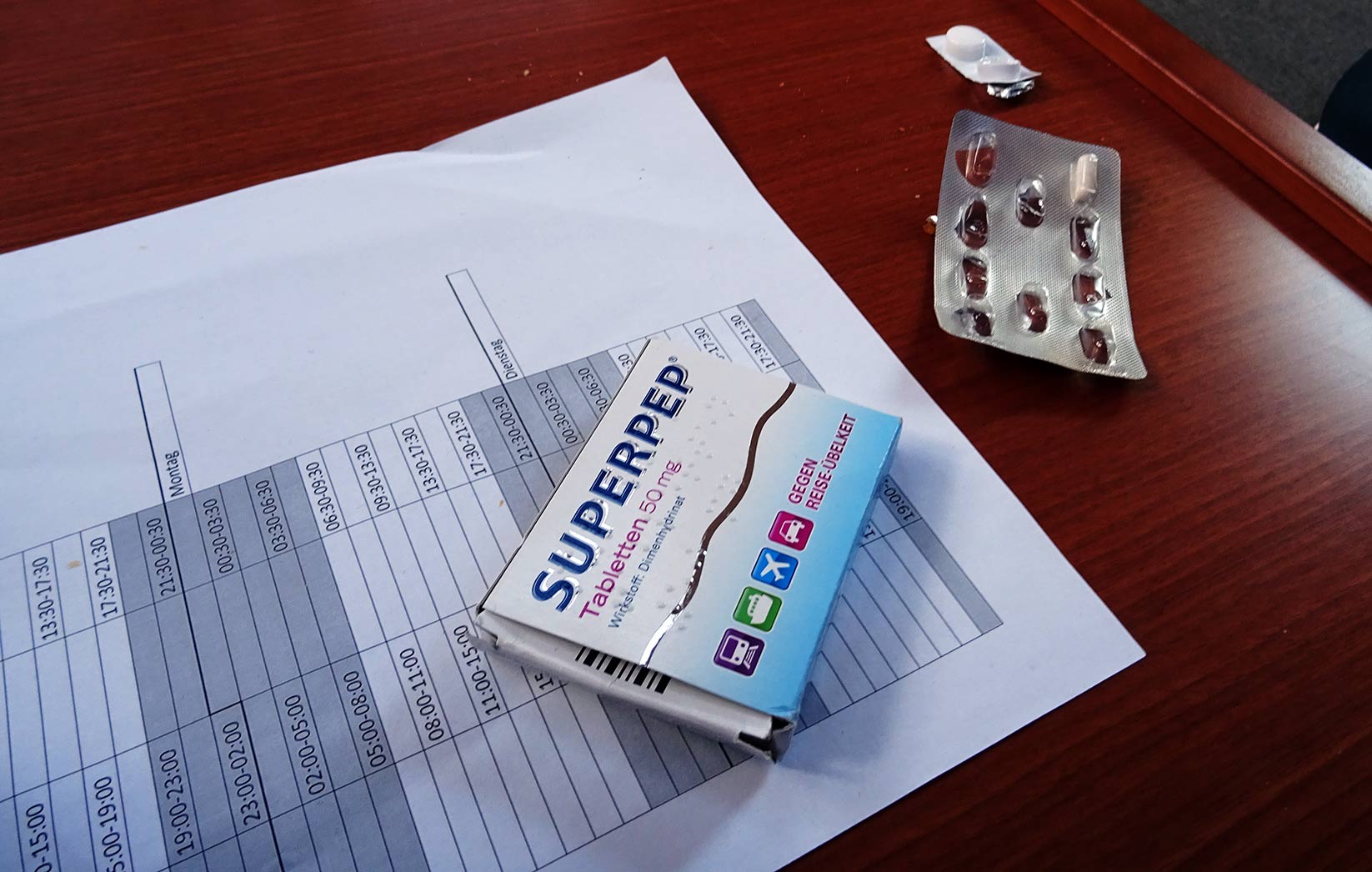
Skipper Wilfried appeared from time to time, checking heading, sails and progress of the boat. But he never stayed longer than necessary, always creeping back into his dark cabin in hope for another chunk of sleep and cure at the soonest. Suddenly the door to the fore cabin opened and a freshly bathed Ute came into the saloon: “I am through!”, she radiated and smiles bright. I granted her this progress and whished for mine to speed up. But what could I do. For the next watch I tried some Aspirin and low-dosed Dramamine. It worked. It had to, because this time the schedule had the worst shift for us: 0 a.m. to 4 a.m.
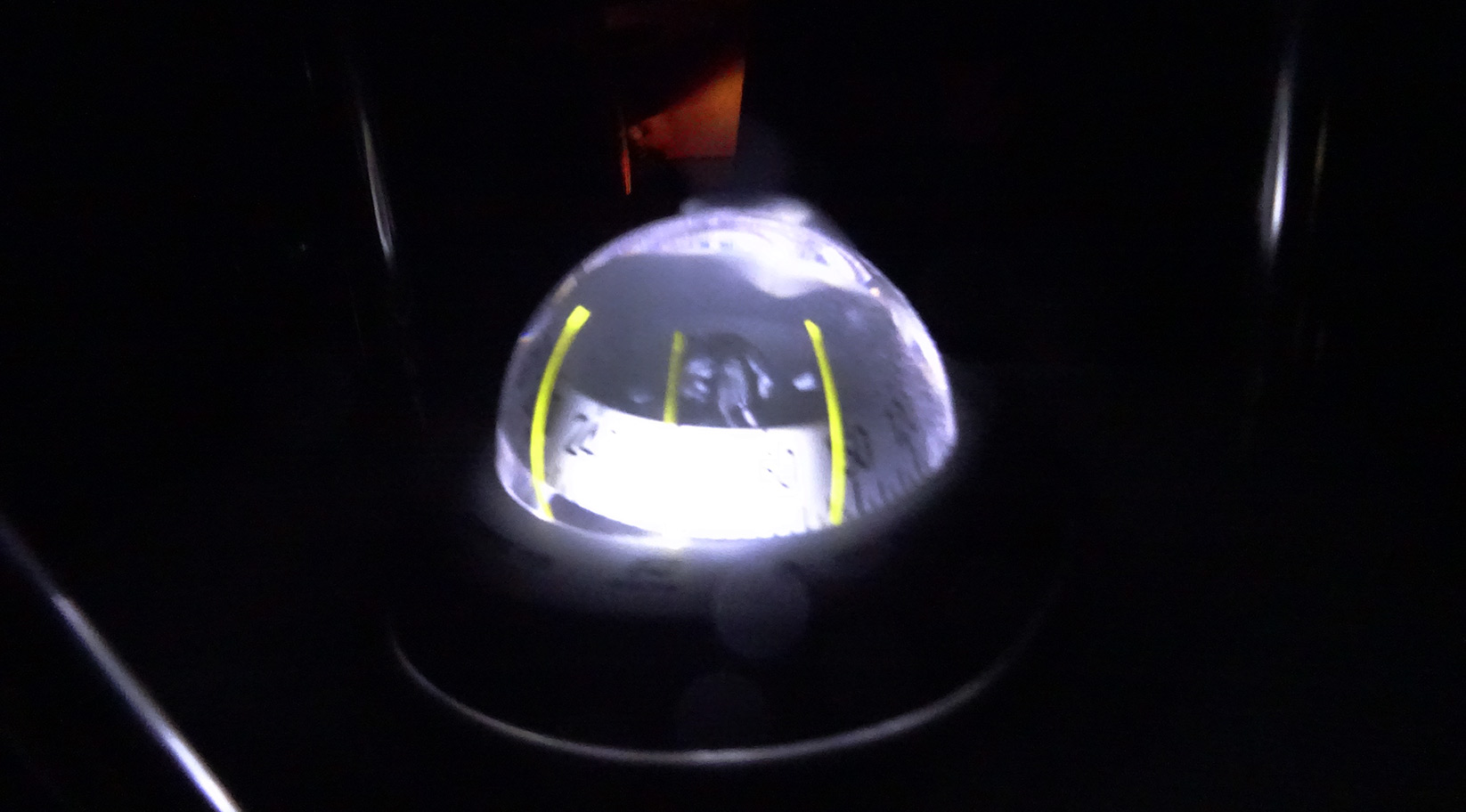
It was a dark night due to heavy clouds. No stars, no moonshine, no nothing. Just plain, perfect, impenetrable darkness. Green and red position lights created a weird lightshow at the bow, the (far too) bright magnetic compasses and the white steaming light illuminated the cockpit, but farther than the border line of our boat there was nothing than perfect pitch black. Just the sound of nearing waves – a deep rumble, a rise in wind speed and as long swoosh – announced another session of up and down of the boat. We´ve made good progress so far and every day at 10 a.m. when Thomas took his smartphone where a GPS-driven tracker counted every motion of the yacht, he announced the fresh numbers of our daily run.

Better than the “dog´s watch” from 0 to 4 was the successing watch from 4 to 8 a.m. due to the fact that during those four hours one could witness the pitch black world returning to life again. At first a light dim in the East. Than a pale light-blue stripe. And suddenly, in a matter of sheer minutes, the sun would break over the horizon, flood the sky with blue, orange and red tones. Then it was a time of rejoice, when the first daylight came through and warm sunbeams begin to hit our faces. Life returns. This was the very moment I specially prepared ourselves to enjoy the most by making a fresh cup of hot and sweet peppermint tea. Wilfried and I would silently watch this spectacle, barely speaking a word but flicking happily.
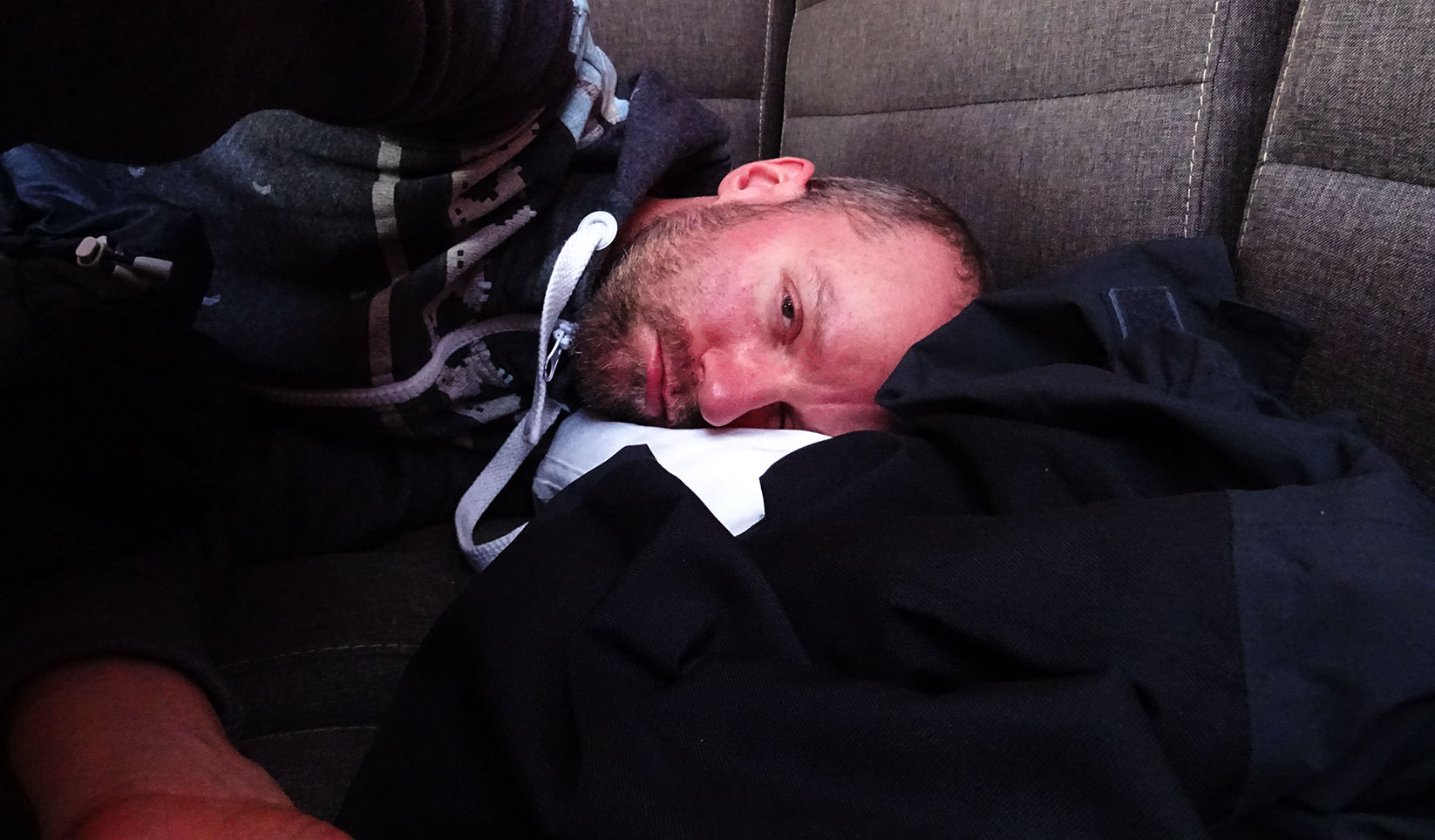
Being relieved of duty I normally go down the ladder, take off the heavy clothing (it was still very cold during the night shifts with temps falling around 10-12 degrees Celsius), rushing to the toilet, brushing my teeth and slipping into my sleeping bag as fast as I could. Applying ear plugs, drawing the sleeping bag over my head and trying to find at least some quiet minutes – I rarely found a deep relaxing sleep due to heavy motion and noise in the boat.
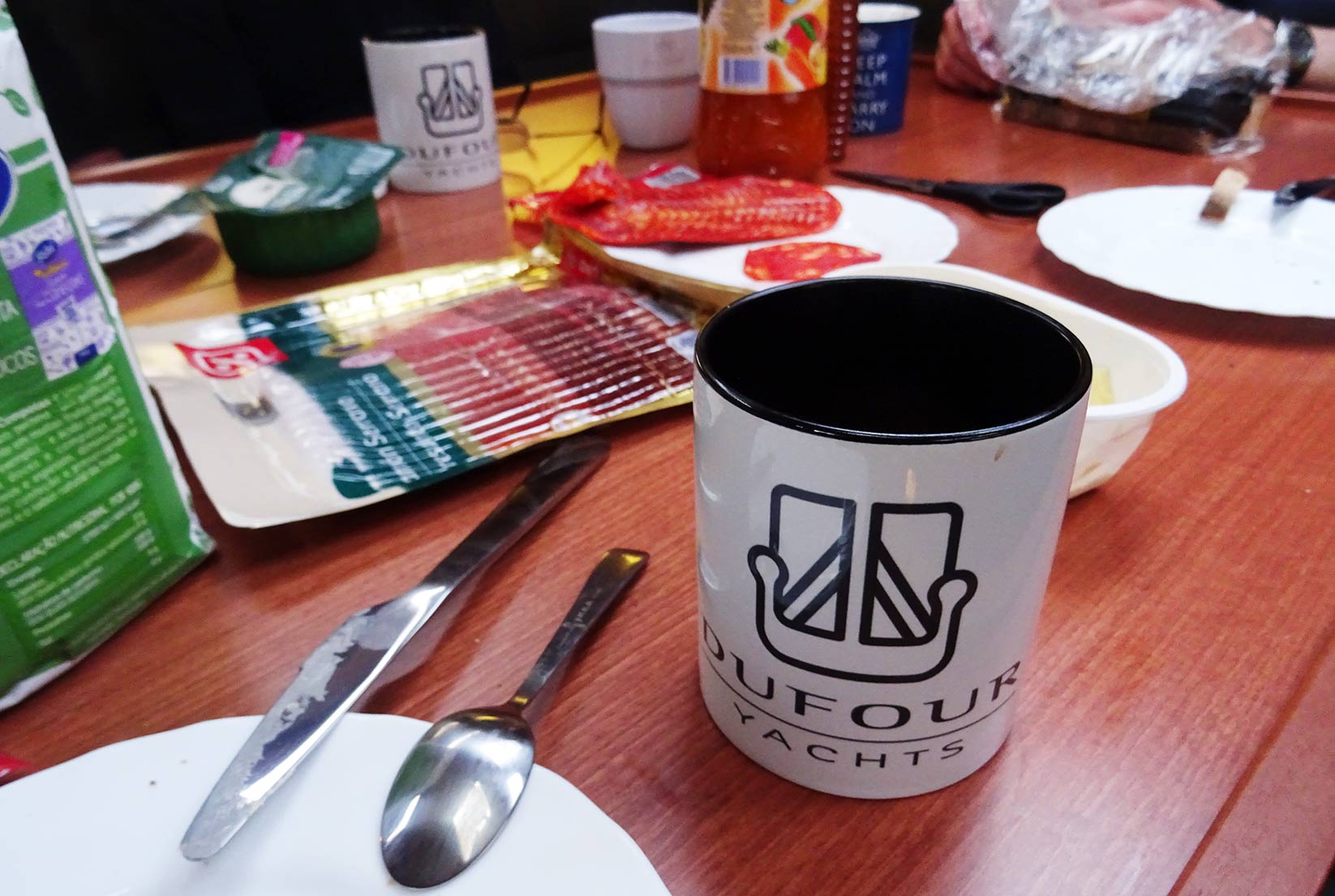
While the others indulged themselves in rich breakfasts – scrambled eggs, bacon, roasted bread with all sorts of facings sweet and salty, fresh oranges in rich muesli-cups with litres of coffee – I couldn´t eat a thing. I even couldn´t stand the smell of their food. I would turn myself facing the cushion trying not to think of filling my heavily beaten stomach with all that fat. Which was interesting as I once read that fatty foot, alcohol and stimulating stuff like coffee would enhance the symptoms of sea sickness. Wilfried and I relied solely on peppermint tea, plain white bread and an occasional banana or apple.
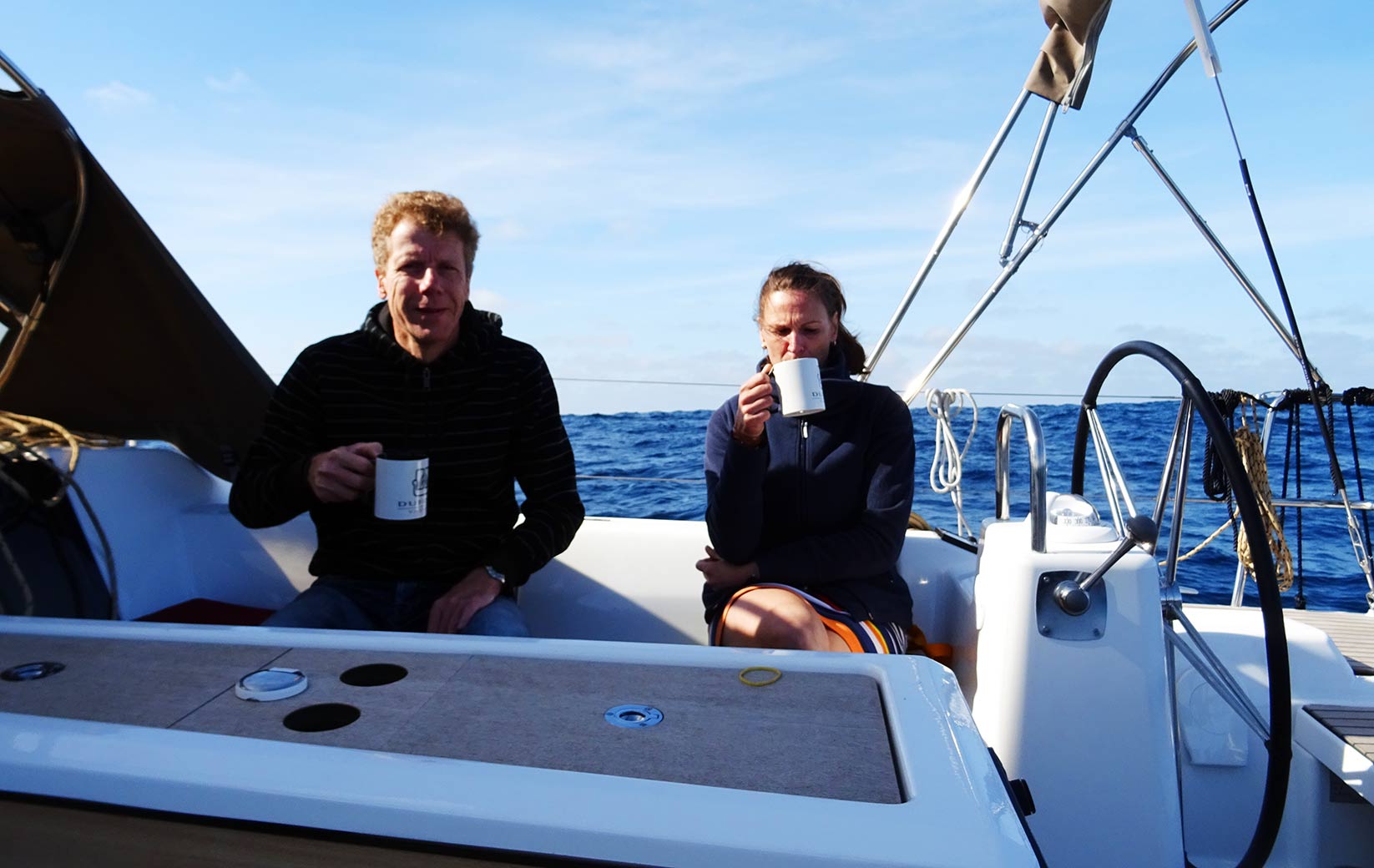
Apart from us two being out of order for the two first days our sailing yacht performed better than expected. We´ve had winds from the back taking us on course 220 on a broad reach. Speeds remained well above 7 knots and so our confidence in reaching our first port more than in time. Slowly but surely life returned to my body, dizziness disappeared and as I put myself back to onboard duties – even below deck – I sensed that my stomach seemed to be accustomed to the motion of an oceangoing yacht now. Things began to be fine now.
48 hours later: Sailing on the Atlantic Ocean
Now that I was back on line and capable of full watches I found back quickly into the daily routine of an oceangoing boat. That was, like on all boats, a well-determined list of things to be done on a daily basis: Down below deck the boat had to be kept clean which meant to sweep the saloon at least every second day to get rid of all the crumbs and sand blown over from the Sahara desert. Washing the dishes was a task to be fulfilled twice a day at least. Turning my bunk into a welcoming settee meant to stuff my sleeping stuff under the navigation table that wasn´t used regularly.
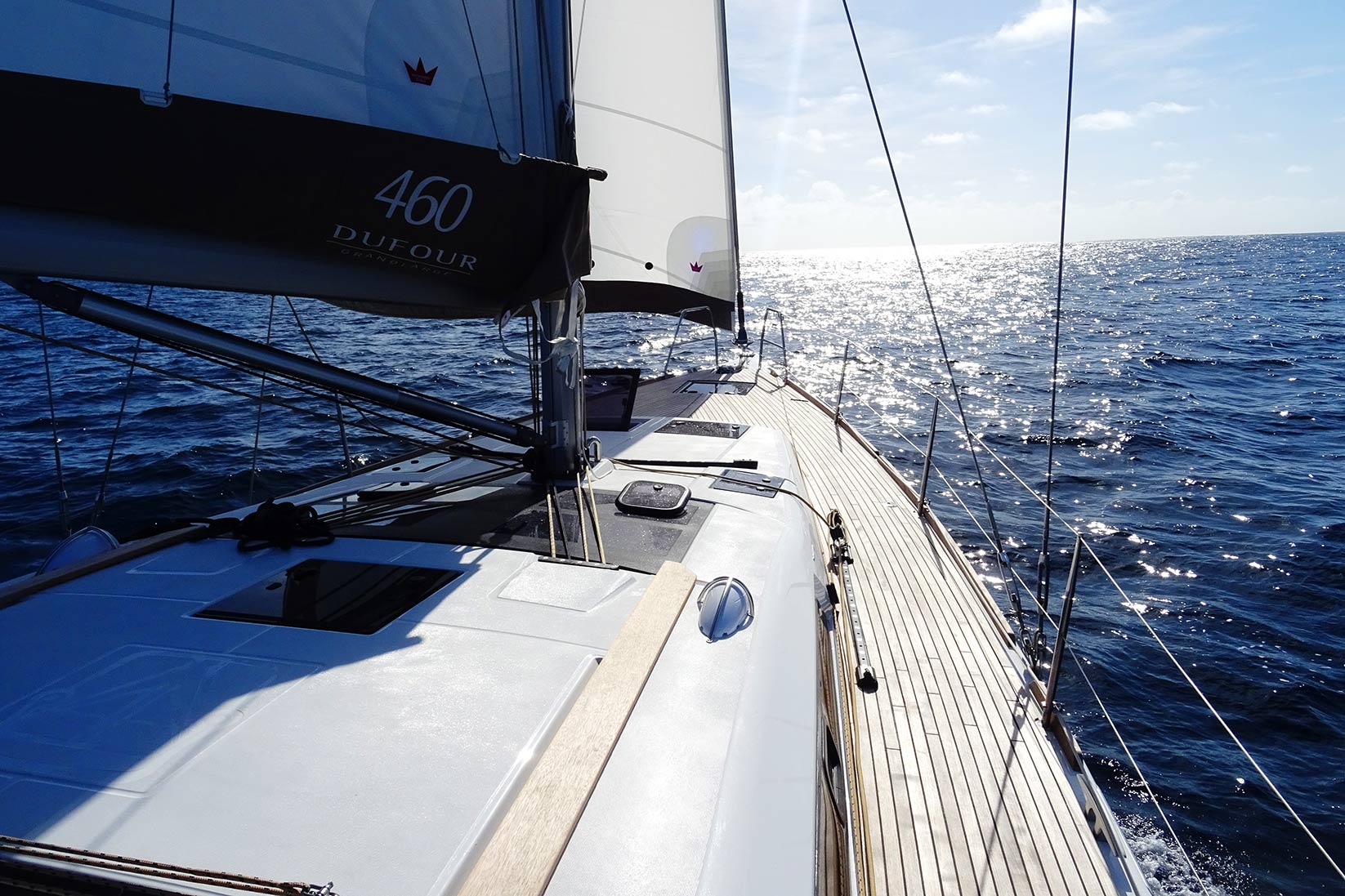
On deck on watch wasn´t that stressful: As the selfsteering gear automatically followed the course and managed to keep our boat pointing to Madeira even in stronger winds with up to 30 knots in gusts with high seas of 6 to 7 metres, it wasn´t necessary to helm by hand. Which does not mean we didn´t: The autopilot´s electric motor was mounted in the starboard locker right above the starboard cabin – and it made the hell of a noise. So granting Thomas or Martin at least a couple of minutes of good sleep, we tried to turn the selfsteering machine off as much as we could. Though I found it very, very hard to helm the boat especially at night with no vision at all with winds and waves from aback.
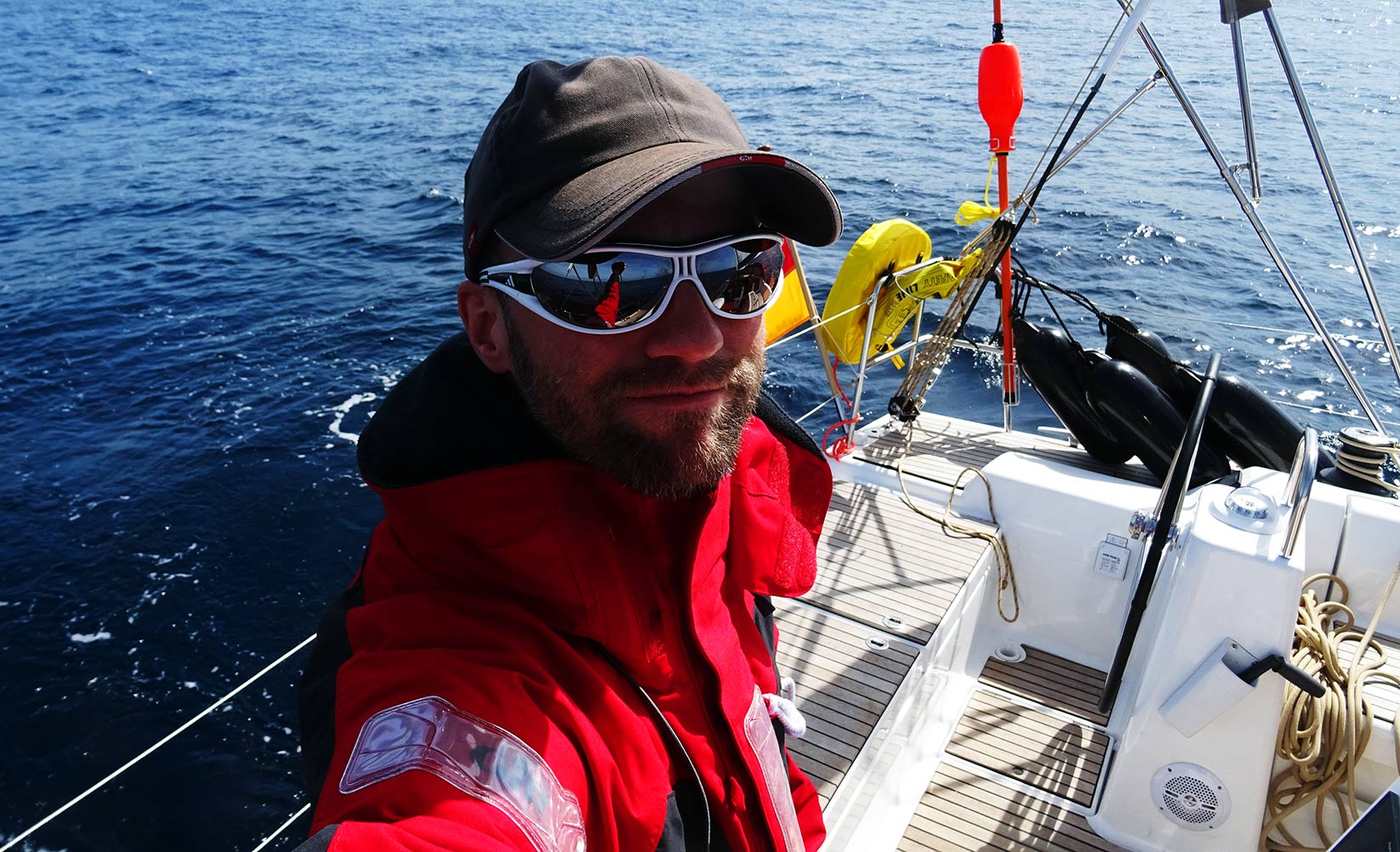
So, most of the time on duty we would sit down behind the sprayhood facing aft, looking at the stars (if moonlight and clouds permitted to do so), talked rarely. Every 15 minutes or so one of us two would get up at take a look onto the chart plotter looking for AIS-signals of other ships, checking for our sister ship SY AVATAR and controlling heading and distance to the next waypoint and the final harbour. Then we would climb the cockpit´s seating to look around visually for lights or floating stuff. After that, we sat down to look at a beautiful Orion in the sky again.
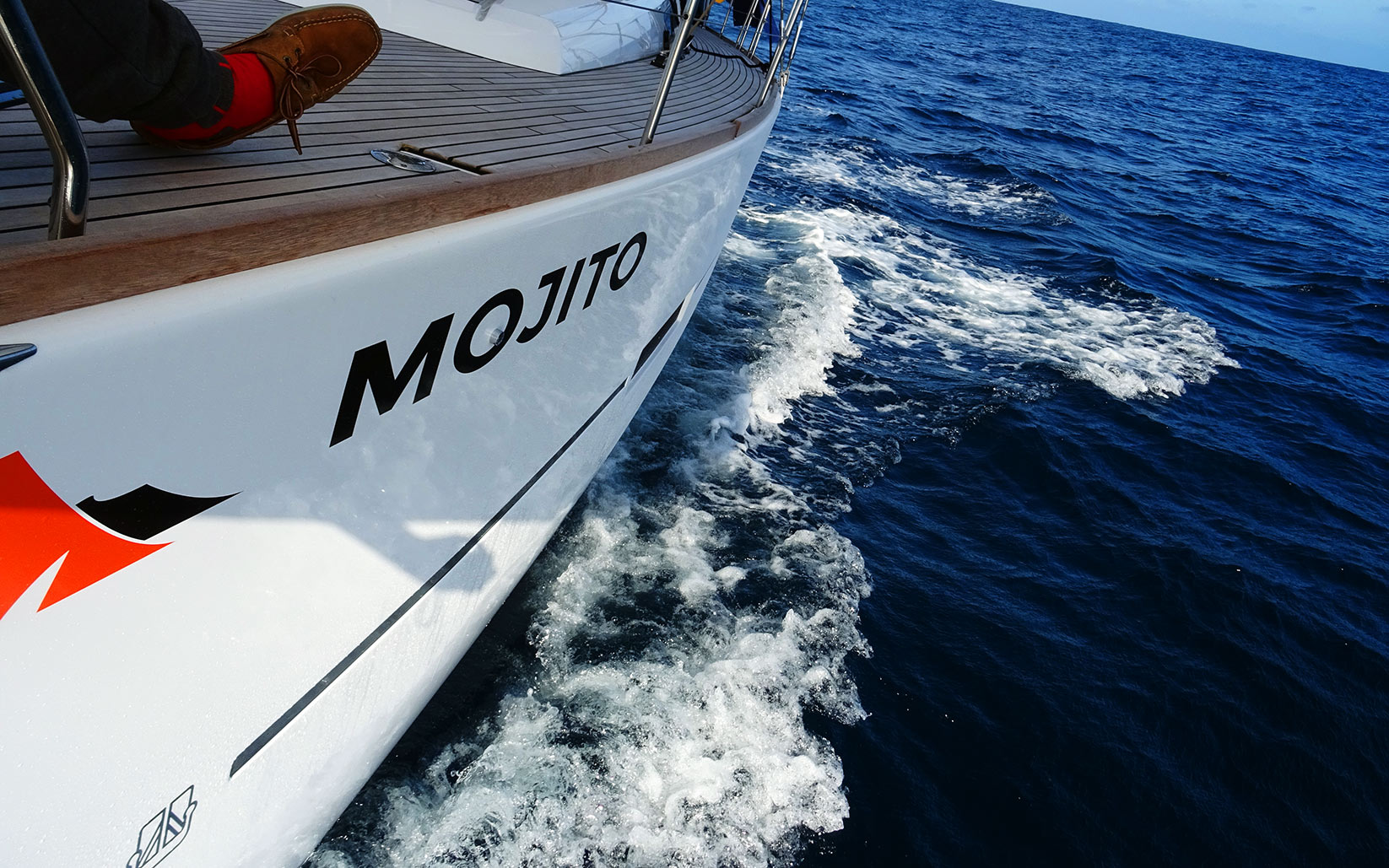
Our Dufour was sailing fast. Very fast with speeds not dropping below 7 knots. On the third day we´ve got the most of the winds on this first leg and sometimes even doubted that our selfsteering would be able to keep the boat on steady course. Surfing the waves down our boatspeed regularly exceeded the 10 knot-barrier with Martin during one night shift suddenly shouting down into the sleeping boat: “Thirteen knots! Yeehaw!!!”. Wearing a life jacket whilst in the cockpit was customary, connecting a life line to the boat during night shifts and whilst roaming on the fore deck a matter of course.
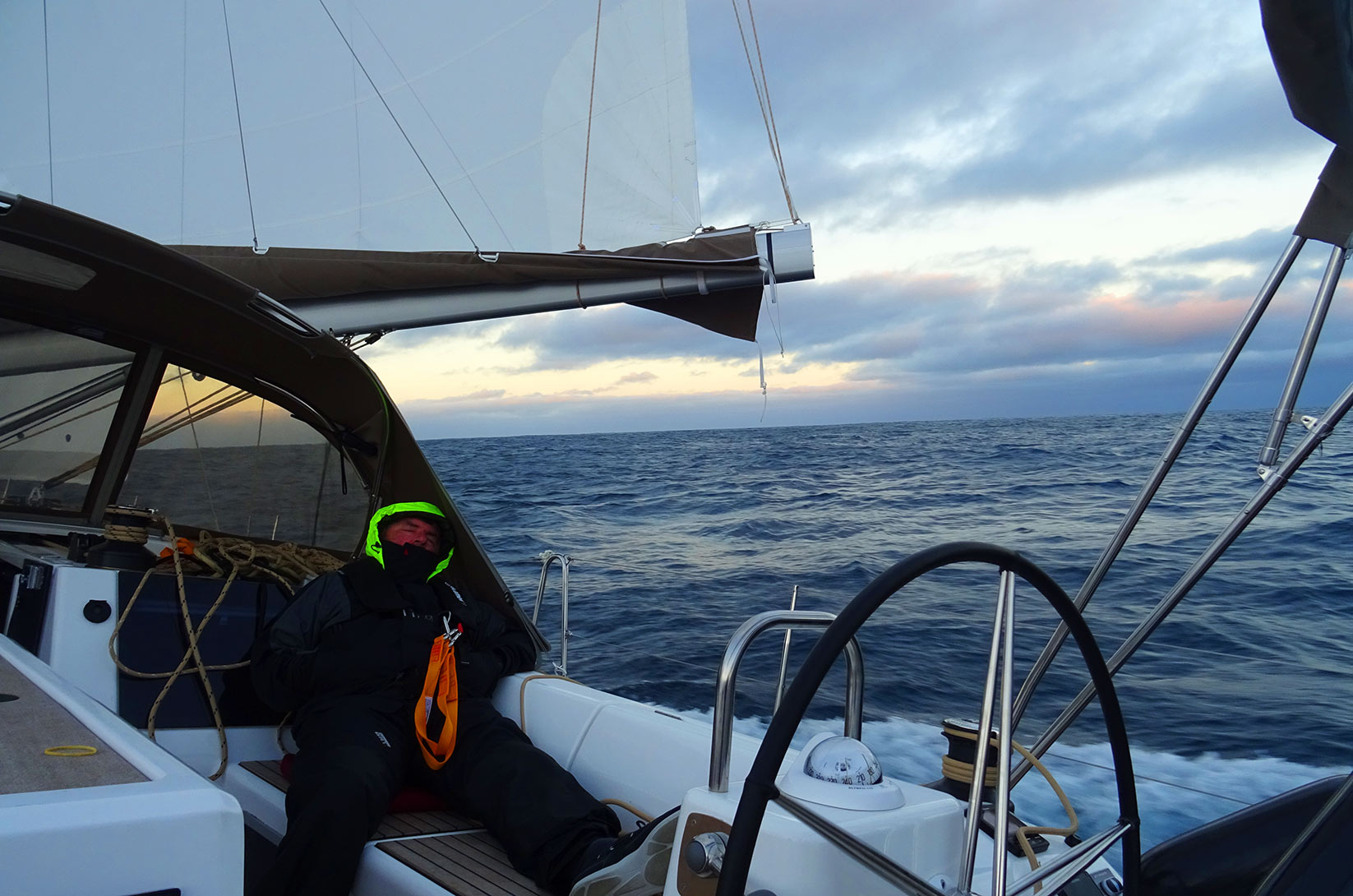
On the third day Skipper Wilfried began to return to normal life again as I noticed an increase in his will to talk during our watches. He also ate more and joined in again in throwing punchlines and nasty, manly jokes – much appreciated especially by Ute who favoured the quietness and “unmanly” boat as she made fun of our malaise. Nevertheless, the constant strain of the watches began to show first symptoms of tear and wear among the crew.
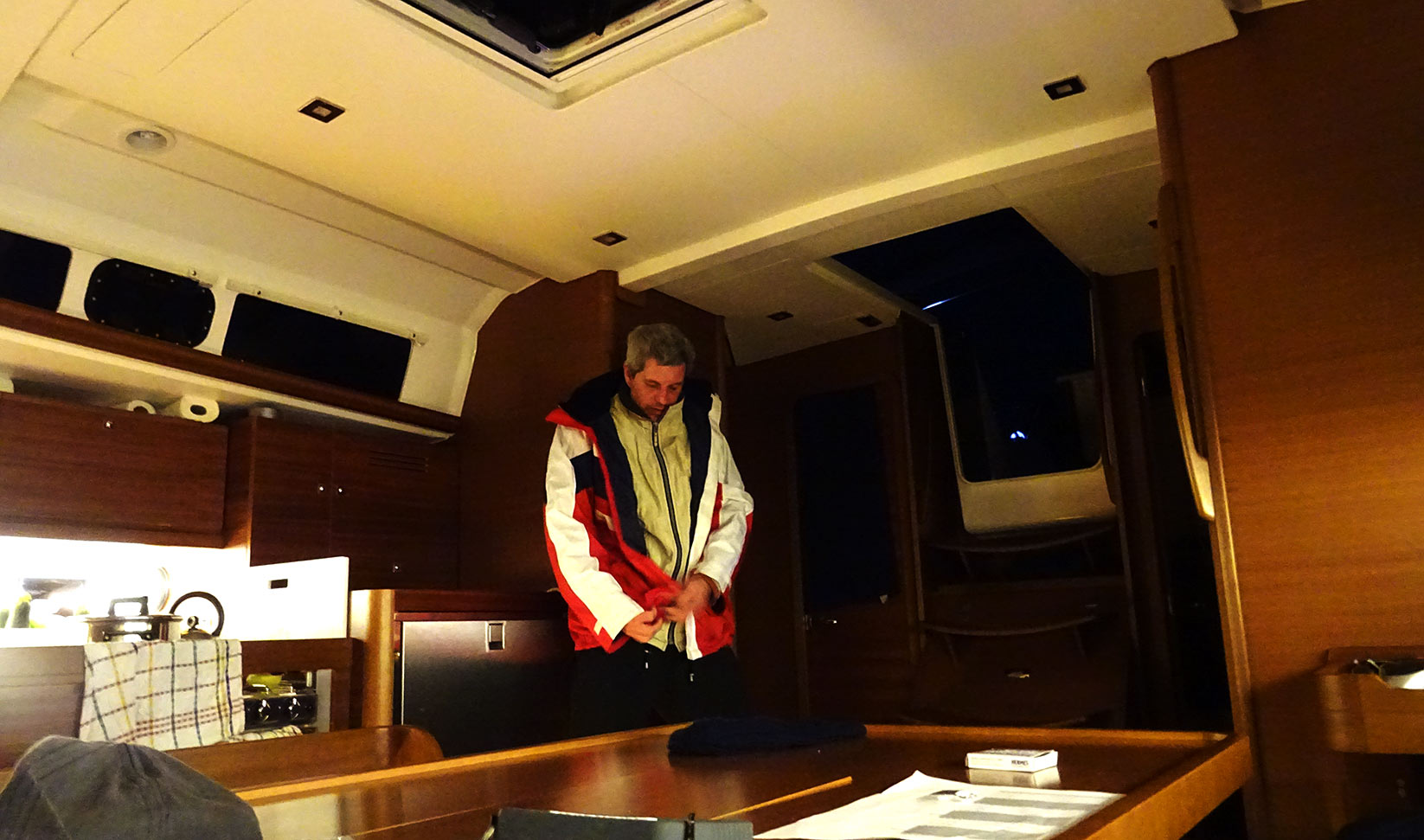
We´ve employed a special system of watches on SY MOJITO: During daylight watchkeeping was a matter of spontaneousness. Somebody always wanted to be up on deck so our Skipper found it unnecessary to employ a full regime of shifts. During the night time, which started at 8 p.m. the first of three 4-hour-watches of 2 people had to be up. Next shift was 0 to 4 a.m. next day and the last – the “sunrise-watch” from 4 to 8 a.m.. Apart from the fact that I personally wouldn´t run a boat on spontaneousness, I found the four hour-shifts too long as they were very tiring indeed. If it wasn´t for the smooth sailing-conditions and 99% self steering I would assume that employing such a regime on a hand-helmed boat under slightly worse conditions wouldn´t work at all. But it did work out for us quite okay.
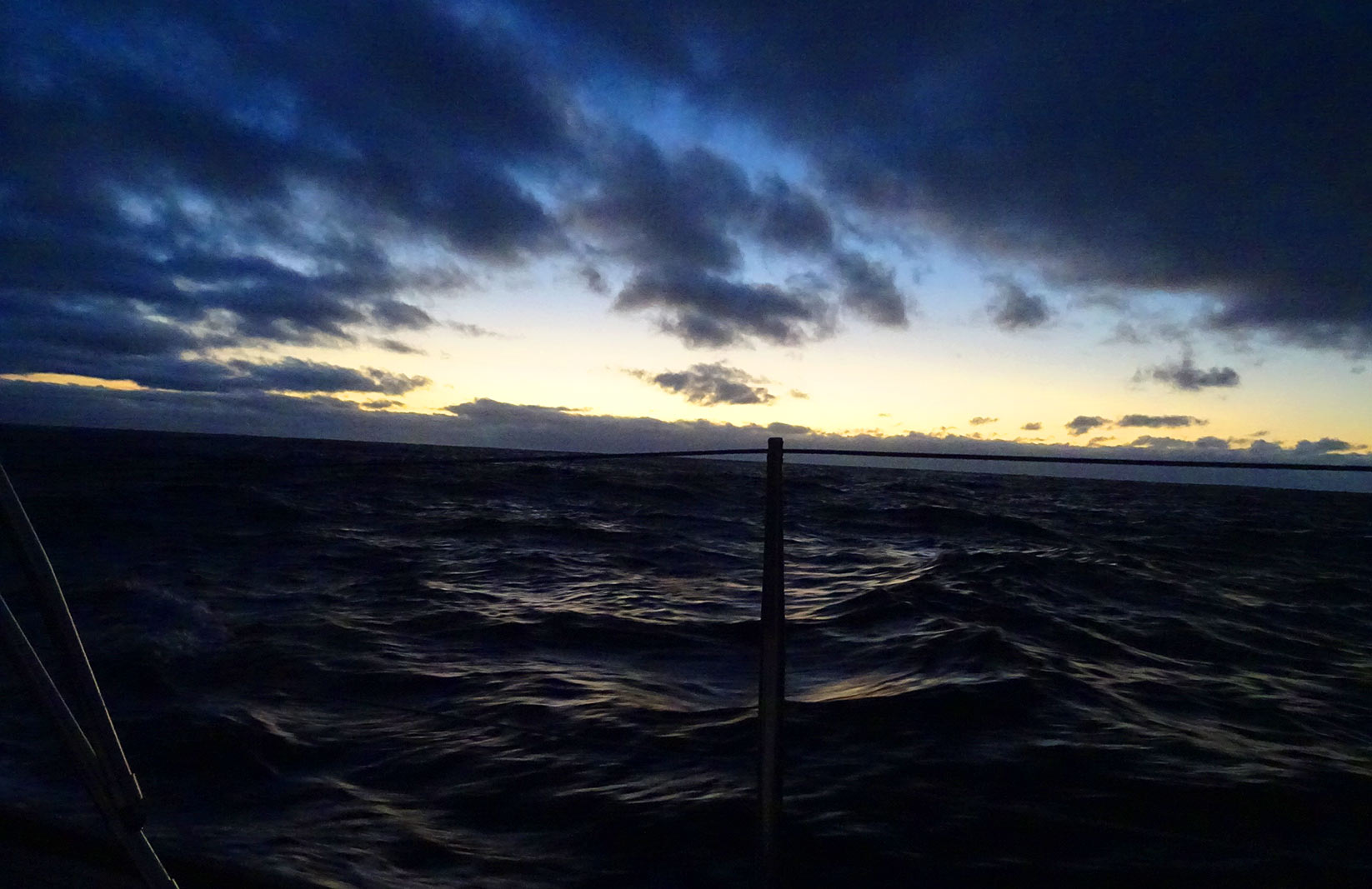
SY AVATAR, our sister ship had a very different scheme of watches. Skipper Sven called it the “flying splice”. As they´ve had 6 people on board (instead of us having just 5 with Martin being the one on solo-watches all the time), his system consisted of daylight watches with 4 hours and 3 hours during the nights. Shifting watchkeepers occurred every 2, respective 1.5 hours meaning that every half a watch somebody would be relieved. Sven believed that this would keep up spirits, as one watchkeeper would meet two people during his watch and secondly, handing over the boat would be more fluent as there wouldn´t be a “new” watch because one of the old watch would be up all the time. We decided not to employ his system because we feared too much trouble.
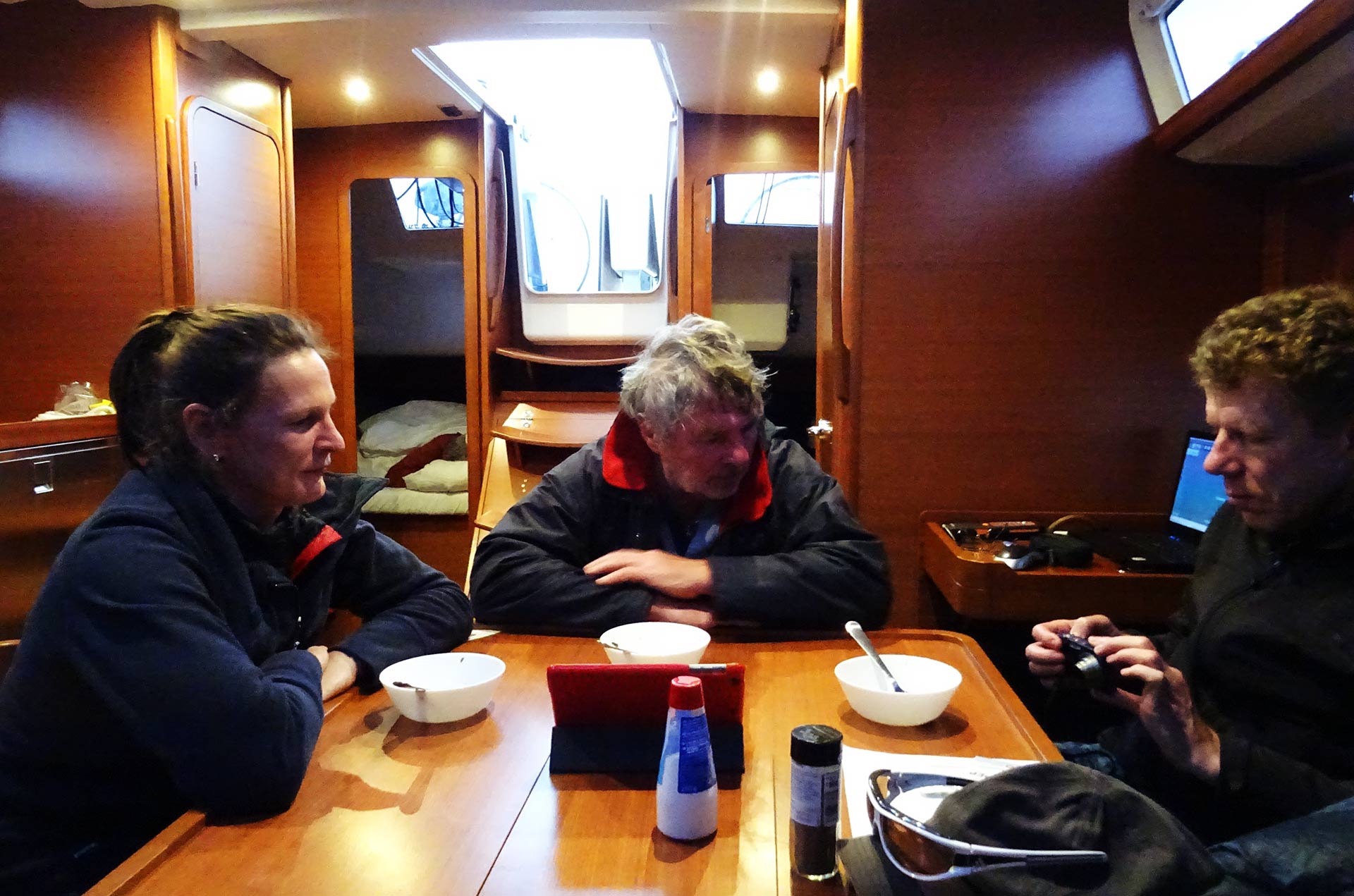
When Skipper Wilfried joined the crew with full force again on the dawn of the fourth day SY MOJITO was back on line with full crew complement and ready for the last hundred or so miles. We welcomed him with a nice breakfast consisting of scrambled eggs, a lot of fried onions and his favourite cheese. Nevertheless, he wouldn´t refrain from drinking hot peppermint tea instead of coffee – something we all agreed to for the rest of the journey.
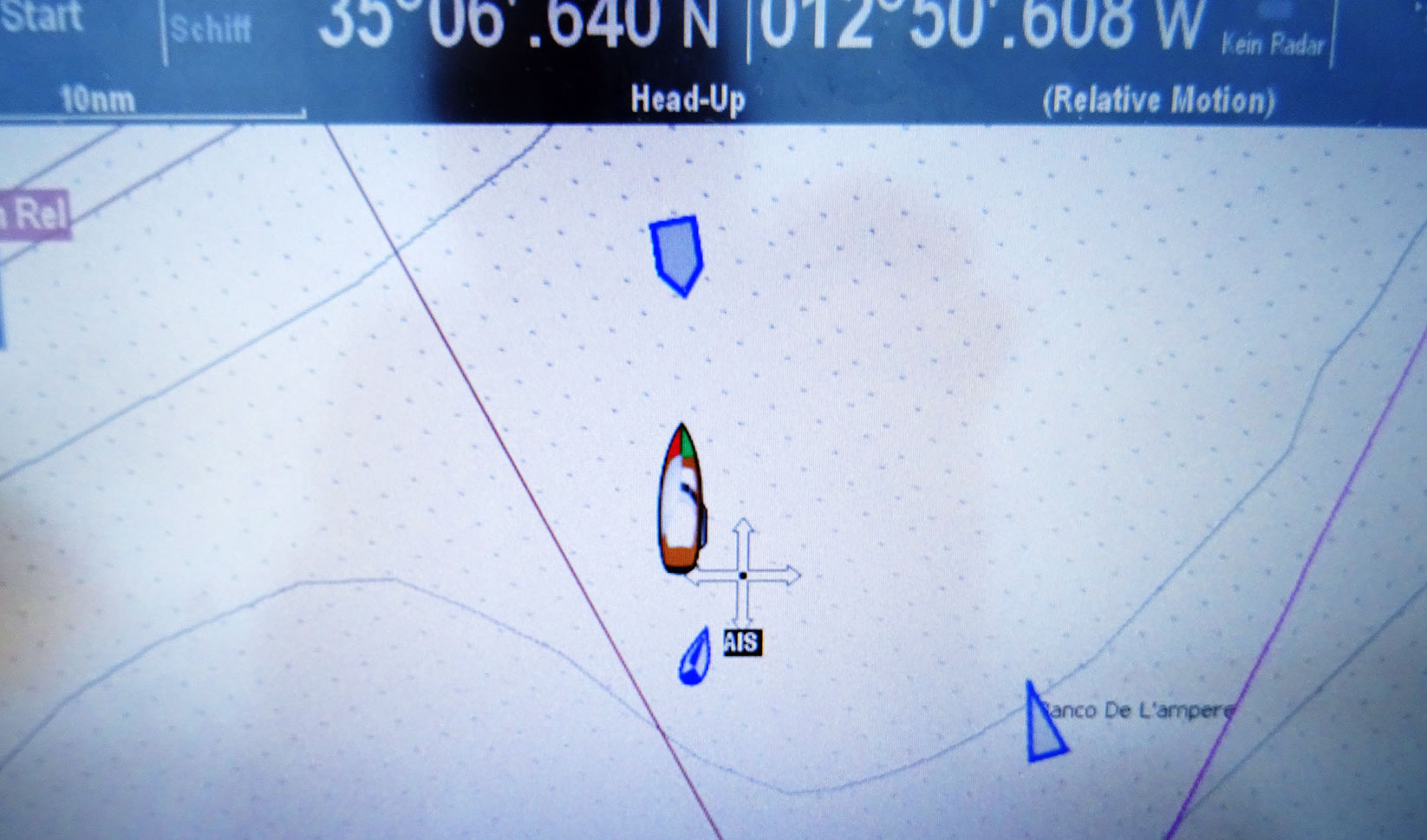
Once we´ve passed the approach to Gibraltar AIS contacts remained a rare sensation. Not very many ships were going South or coming up North so that every single AIS contact was a sensation of it´s own. I very much appreciated this technological magic, seemingly replacing good old Radar in some respects. I loved to check the dynamic data of the contacts for ship´s names, destinations, courses and stuff. On one occasion we spottet a huge MSC freighter approaching our course. He slightly corrected his bearing but still seemed to pass our course in a very low proximity. All hands on deck – this is something you don´t get to see every day.
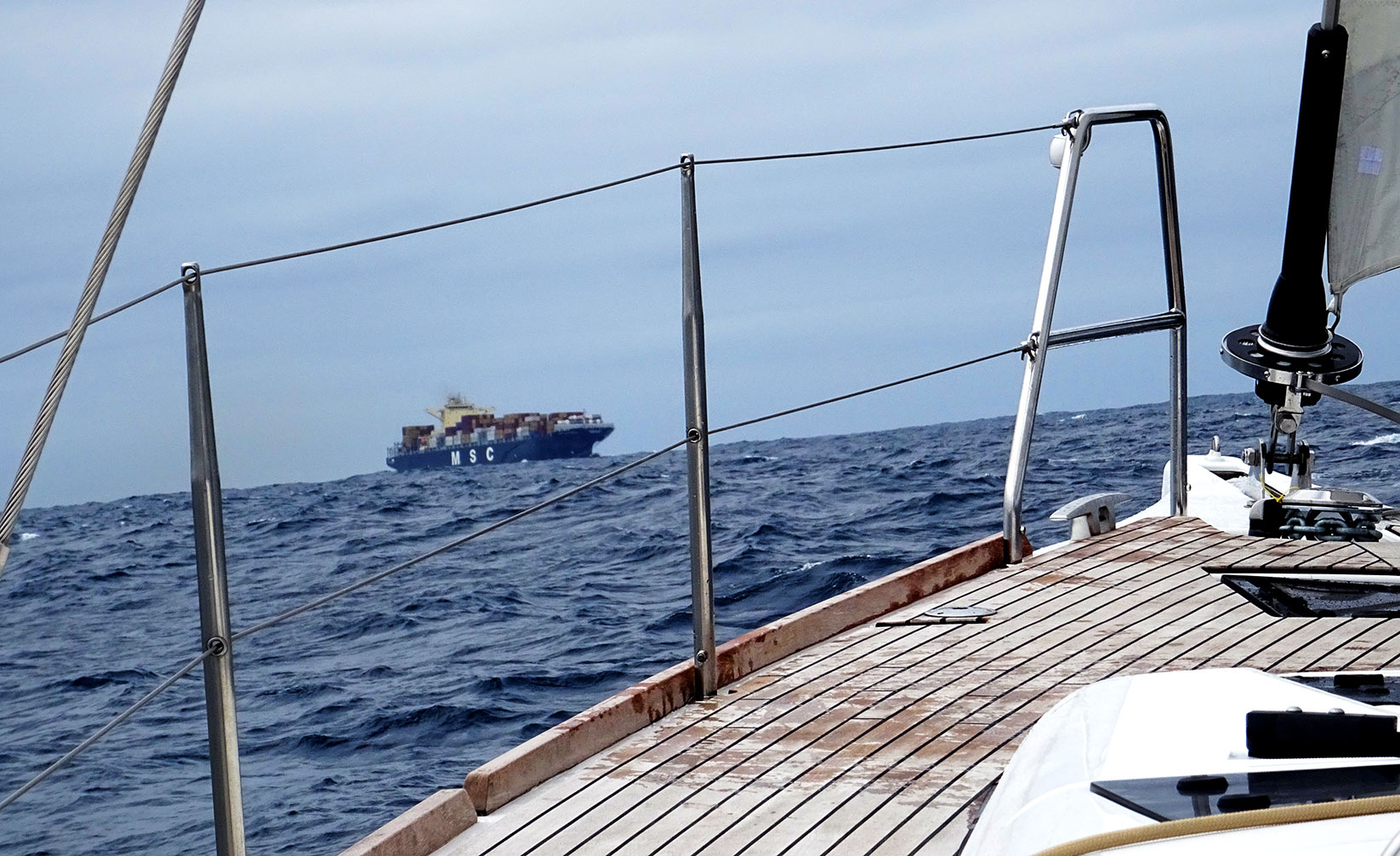
The huge hulk passed our bow in some 1.000 metres distance. As we got accustomed to our own boat´s motions we were fascinated by the slow – but quite heavy – rolling of the steel giant passing us with some 17 knots. We waved a greet and I regretted not to have any signalling flags aboard send a greeting over to the alien crew. Soon the ship was on the horizon again and one hour later their AIS blimp disappeared leaving but an empty ocean.
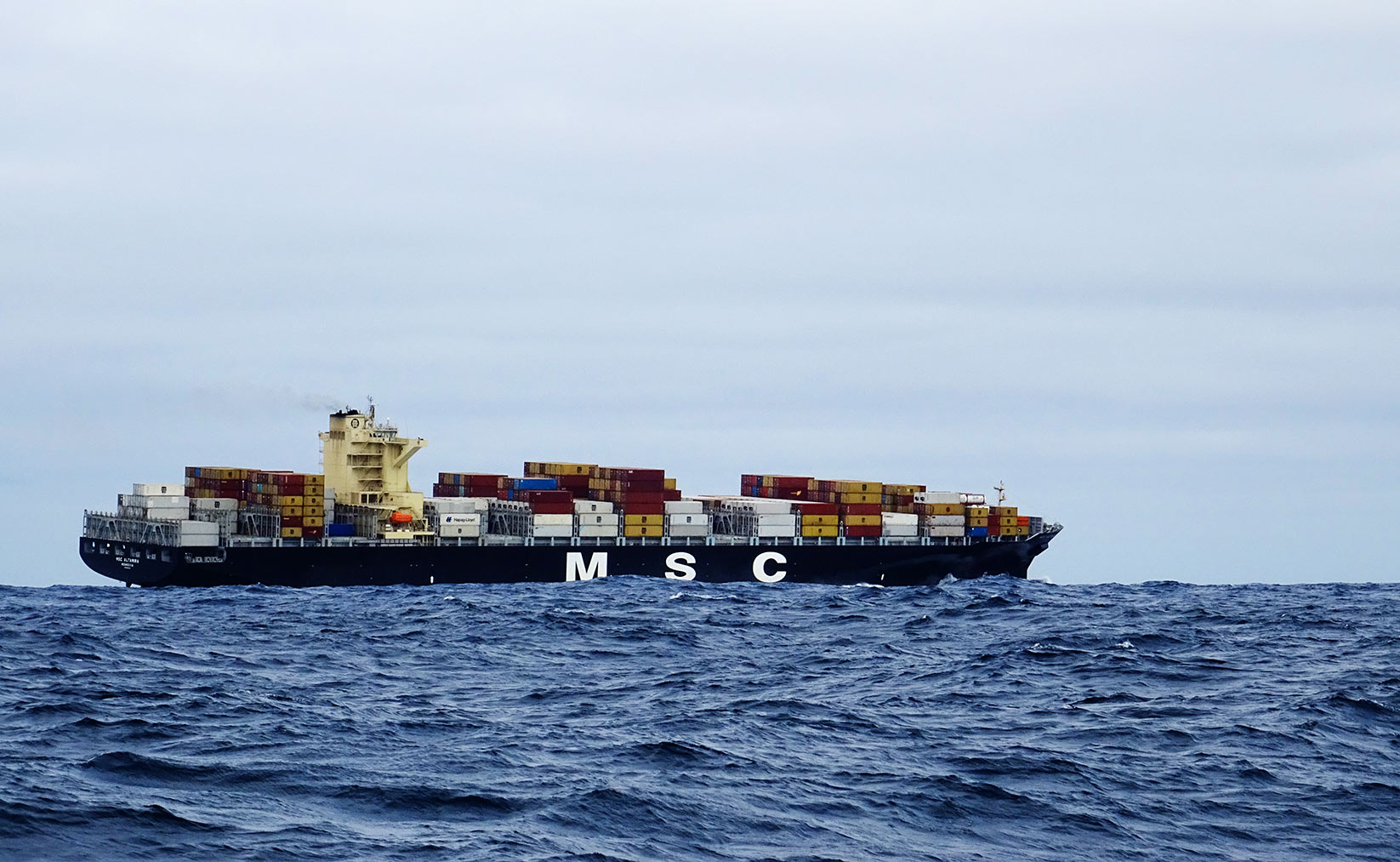
AIS makes it possible to replace Radar at least on the “normal” open seas, as I was discussing this matter on one watch with the Skipper. I wouldn´t skip Radar when entering extreme Southern or Northern regions as icebergs have no AIS transponders, but even on a “normal” circumnavigation a high quality plotter and AIS-technique will perfectly do it. Again, I was puzzled to see that even the biggest super tankers would alter course for a tiny 14 meter sailing yacht like ours. Without AIS this wouldn´t be as easy for them.
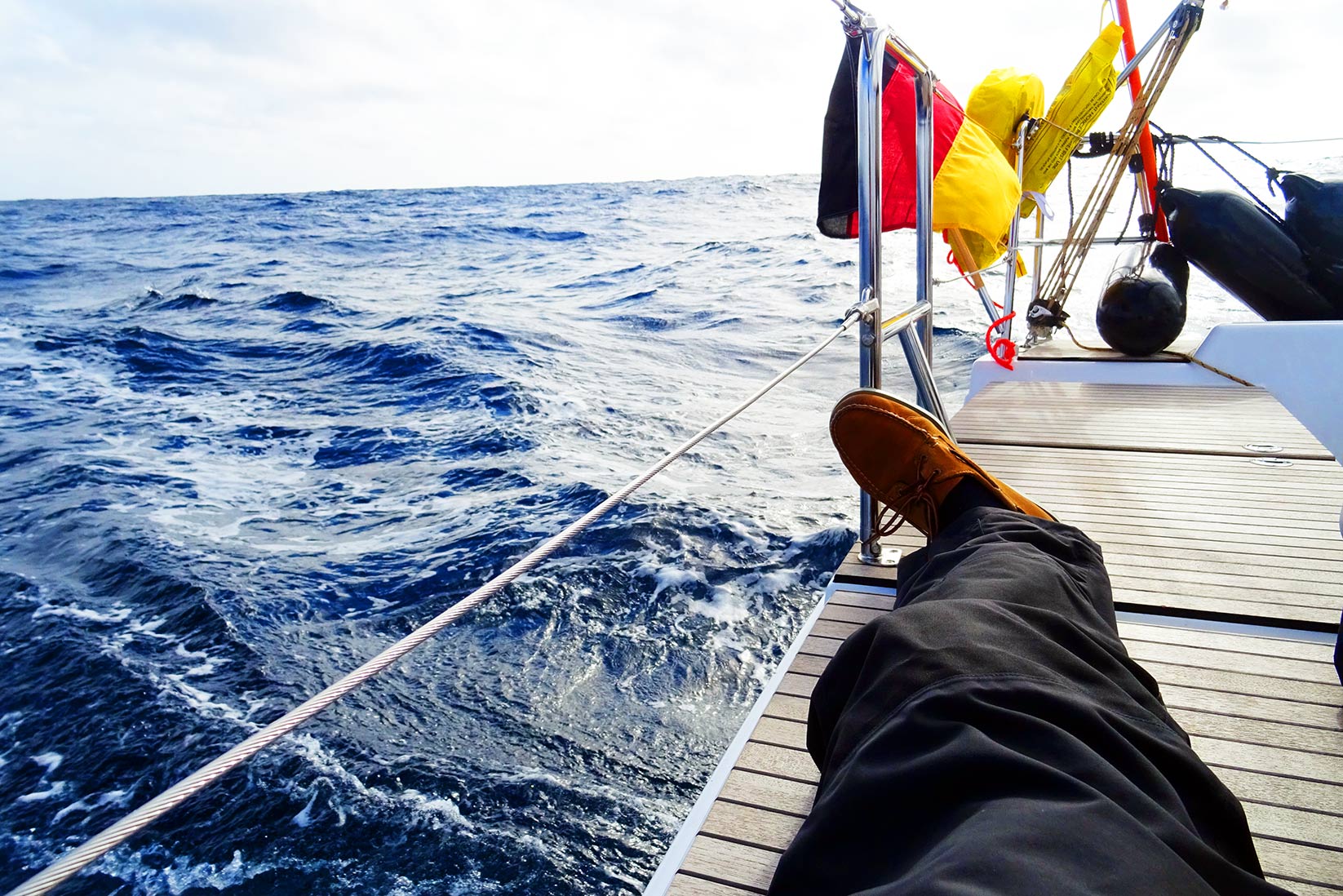
So we sailed on through the ocean and tried to keep spirits high with occasional celebrations like: “Now we´ve reached the deepest point of our whole trip.” or the all-beloved halfway celebration. As seasickness was of no concern anymore we could turn our attention to sailing again. Will we be able to bean SY AVATAR on the first leg of sailing? Up to the third day we kept a lead of some 10 miles over them. But things changed during the last night.
Performance of the Dufour Grandlarge 460
As the third day bestowed us with strong winds from abaft, sailing on starboard bow, it eased during the night. Martin was on his solo watch and I told him in any case of needing a hand he should wake me up. He did at 3 a.m. stating that wind had eased considerably and veered. “I was luffing all the time but now our heading is so poor.” Decision was made quickly to gybe in order to run on a more southerly course. Thanks to the electric winch gybing is a matter of one minute – and we managed to perform this maneuver without any noise nor waking up anybody.
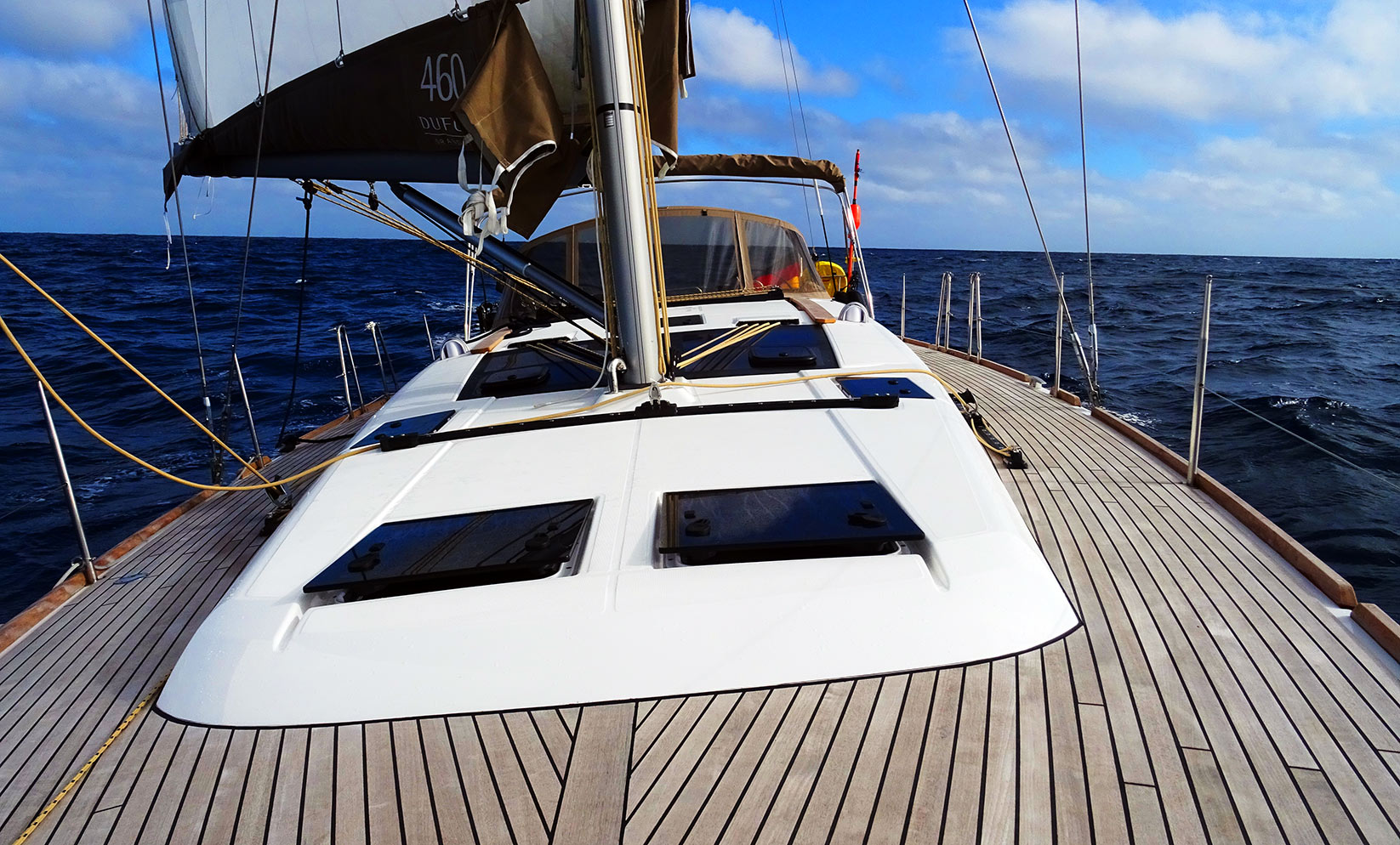
Quickly our boat regained speed, slower than 7 knots of course due to the light winds, but as SY AVATAR kept on creeping on the old course – as we thought on the wrong course as we expected the winds to shift further – we were diametrically moving away from our sister ship. When I assumed watch after Martin the blimp on the AIS was gone and we were alone on the ocean.
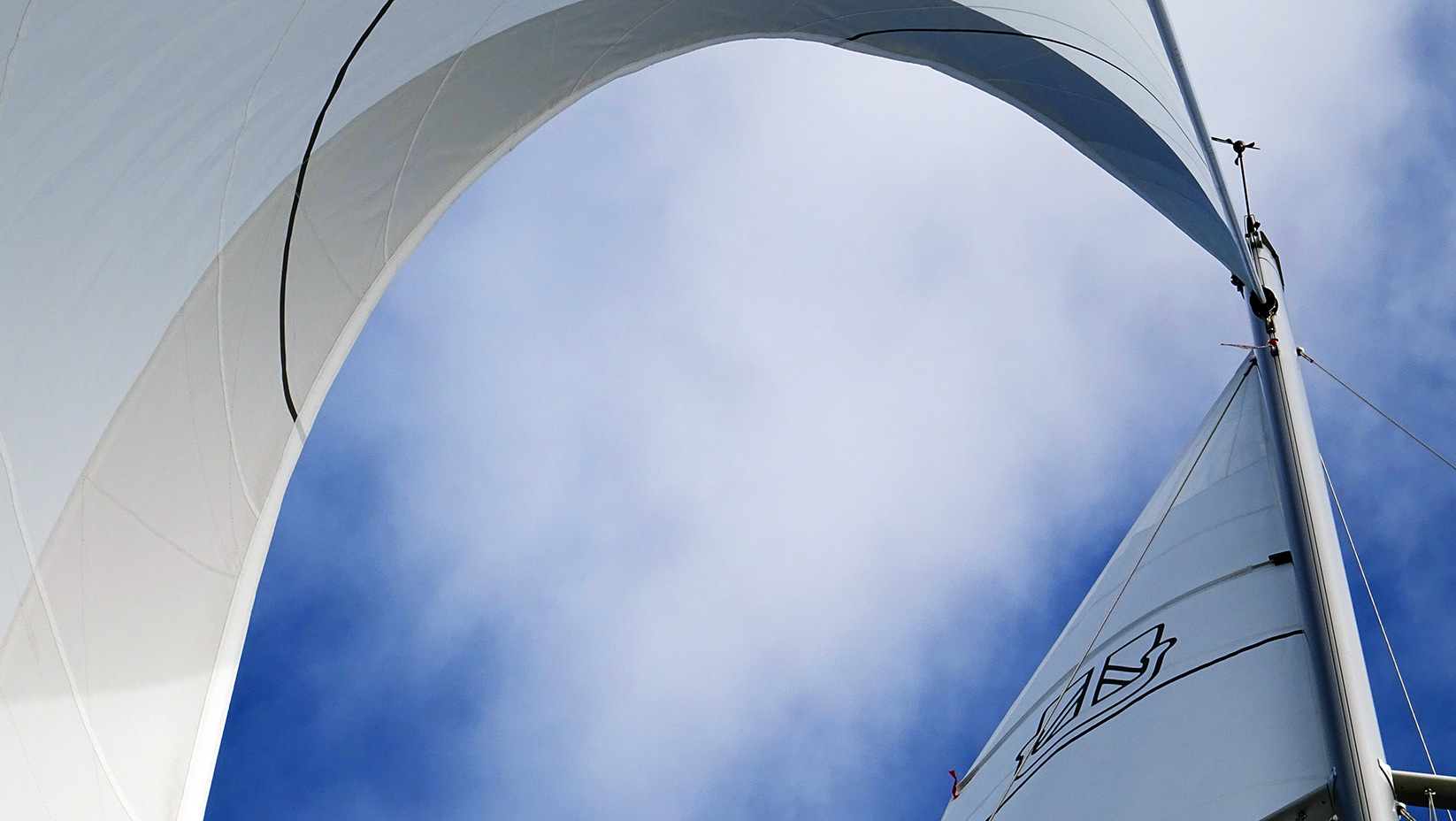
Sailing a Dufour Grandlarge 460 is a no brainer. As I stated, we replaced German Cupper mainsheet roping with the traditional one-line-on-starboard-cabinwinch-system with which we all felt more comfortable. Reefing the furling Genoa is a matter of seconds as I figured to relocate the reefing line from the Genoa winch more forward to the E-winch and take in the Genoa without any efforts. Reefing the main also proved to be of no problem as our Elvström-sails featured a one-line-reefing system. Performing the feared gybe was great fun and done just neatly in a matter of one minute without any stress of bang of the vang.
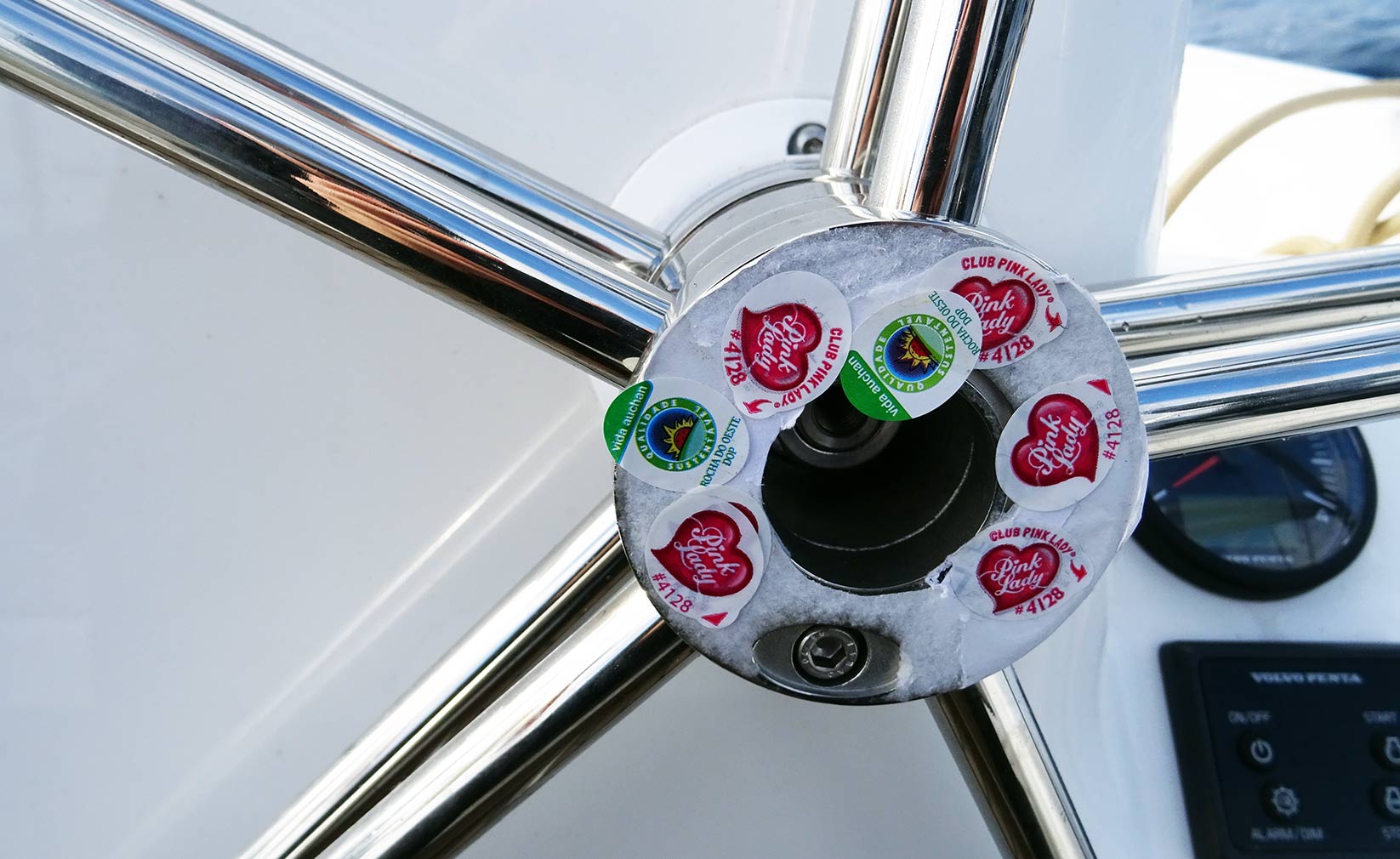
It was a cruise all over the place, not that hard Atlantic sailing I expected prior casting off. We´ve had plenty of spare time, even during watches due to the fact that most of the time our sixth crewmember Mr. Selfsteering held the yacht steady on course. Now, that I am back at home I whish we would have done more helming by hand, but that´s something I can make my practicing aim for the next big trip. As we all – why, we didn´t really knew – fancied eating tons of apples we developed this tradition to put the Pink Lady-apple stickers to the steering wheel. Well, better than making a hack into the Teak …
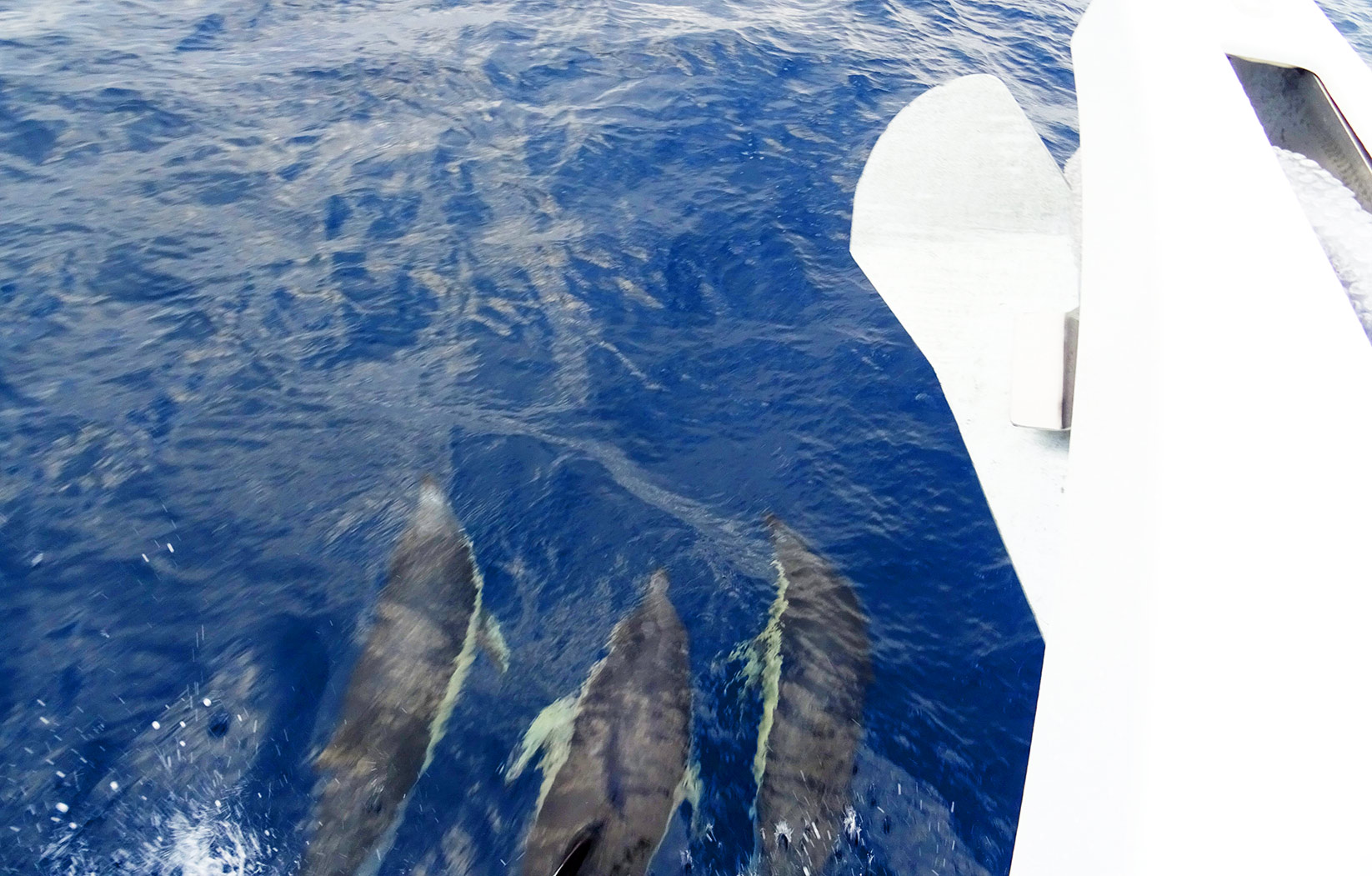
As we came closer to our first landfall, the Island of Porto Santo, on the fourth day, we met Dolphins at last. A school of more than 100 animals came from port side abaft and overtook our boat with ease. These fine creatures played with our bow, dived stylishly below our keel to the other side of the boat and jumped elegantly from wave crest to wave crest. When I went to the bow and whistled, it seemed to me that some of the Dolphins turned to their sides and directly watched me with their eyes. It is always such a special moment when humans meet these gracious animals.
Reaching our first Harbour: Porto Santo
Upon nightfall, some 20 miles off Porto Santo, SY AVATAR returned on our AIS screens: In front of us! Somehow they´ve managed to grab better winds up North than we did. But apart from not being able to beat Skipper Sven, we were relieved to see them arriving in time and safely as well. Porto Santo is a small Island some 30 miles north of Madeira and we decided to make our landfall here due to fresh weather forecasts promising strong gusts for Madeira for the coming days. Porto Santo – never heard of this Island. When it got dark, Wilfried shouted “Land ahoy!”, and we all stormed to the cockpit to witness this moment. Well, “moment” is an understatement as it took us further 2 hours to reach the Island.
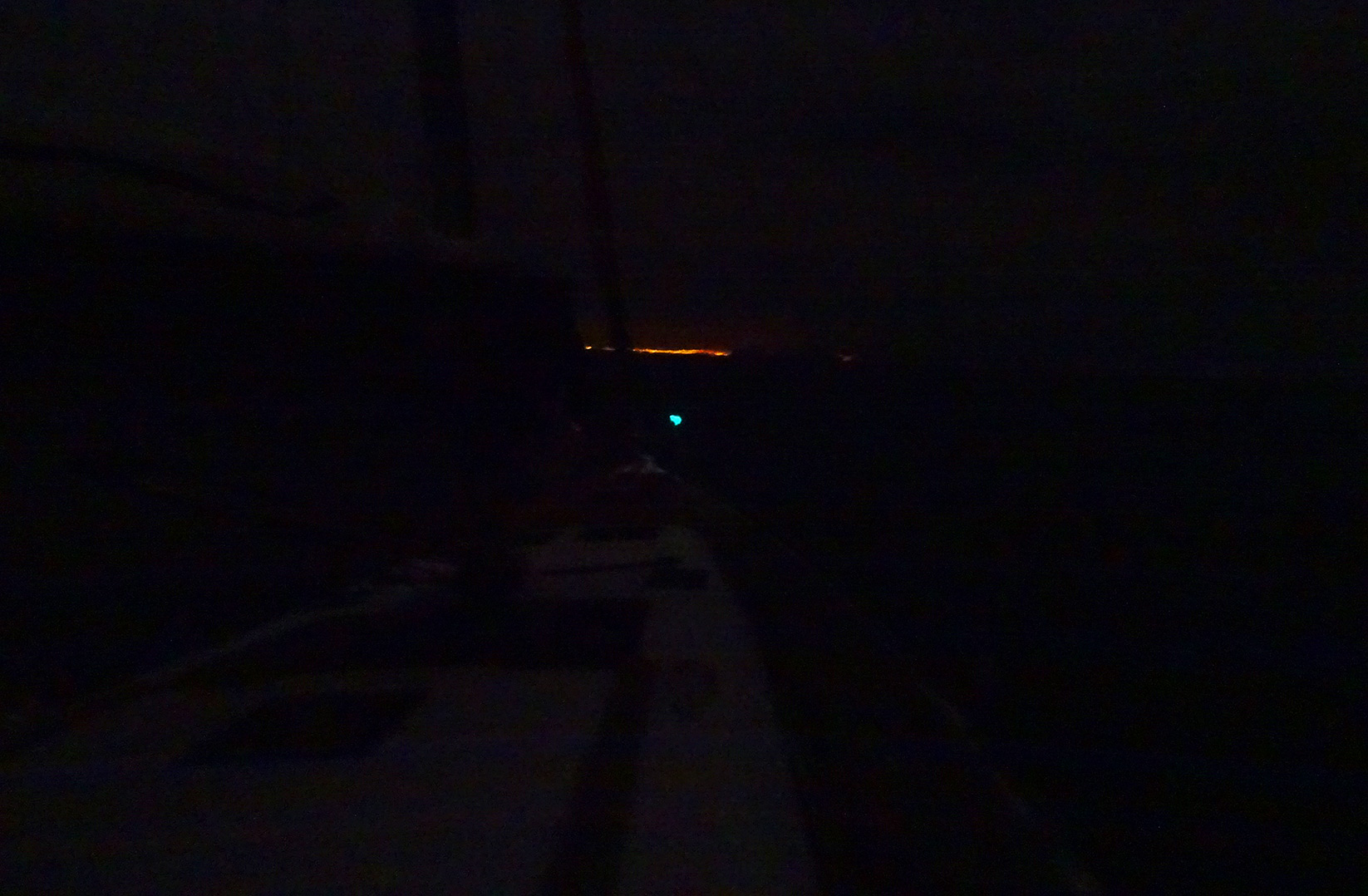
We entered Porto Santo harbour at 2 a.m.. Fortunately the crew of SY DON CARLOS, the 51 feet flagship of LAVA CHARTER fleet and SY AVATAR was still awake, together with some fishermen who helped us mooring the boat. Sights were very poor as the harbour doesn´t bear lighting, very strong eddies punished our boat, puching it violently in the direction of the concrete pier. “There is no free berth in the marina!”, the harbour master shouted: “You´ll have to tie up at pier side of the outer harbour!” That wasn´t good news! More than 2 metres of tidal change, no floating jetty and a concrete pierside with steel framing. Skipper Wilfried, tired and worn out, was cursing as we landed the boat and brought out the lines.
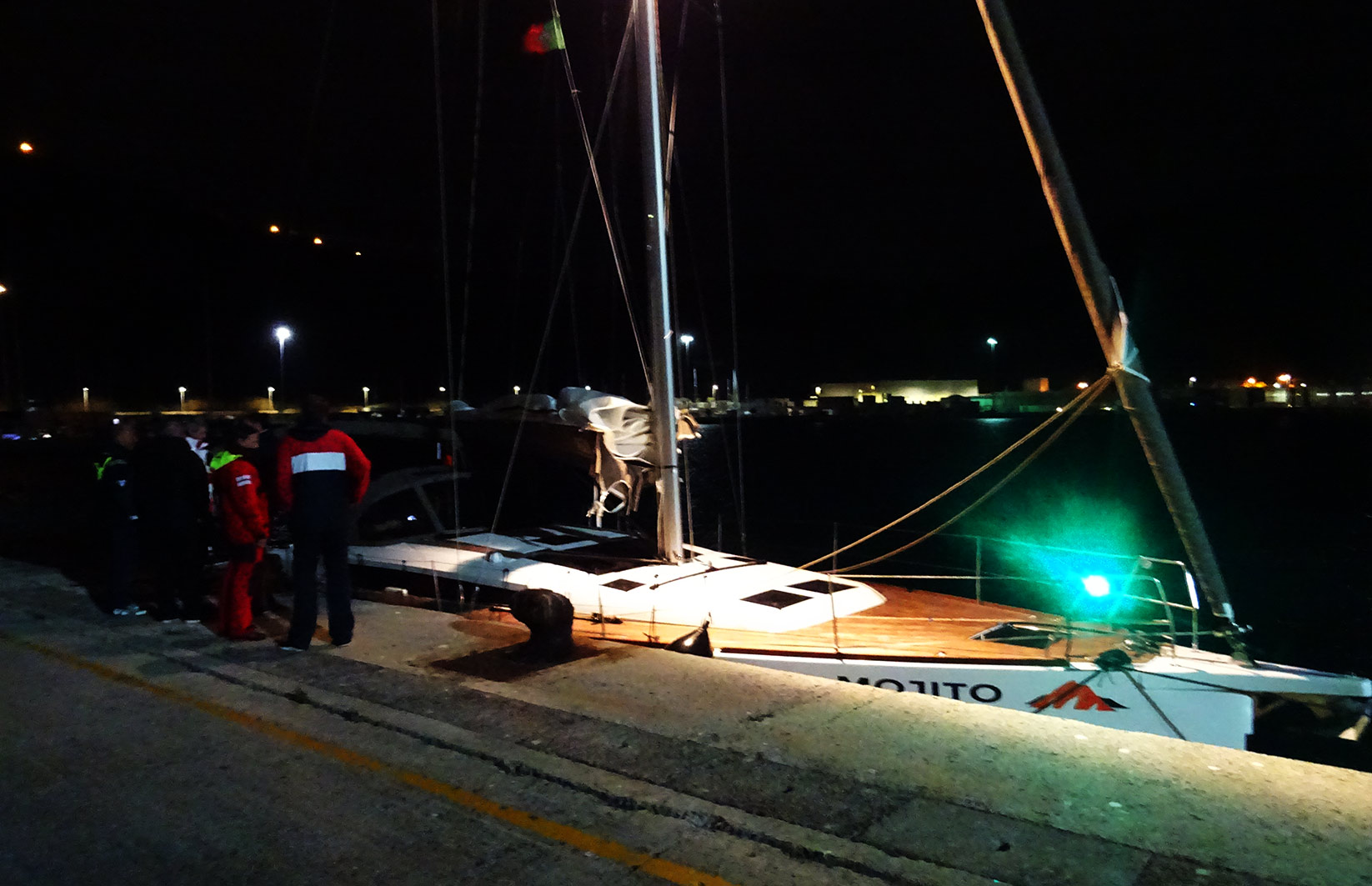
As SY MOJITO was finally tied alongside pier we put aside the strain, hugged our friends from the two other boats and suddenly the stress of the past 4 days dropped. We felt an uncomfortable rocking motion as we stood on solid ground again: “Wait for the showers!”, Wilfried joked: “I once fell hard on my face as I tried to take a shower with closed eyes …”
After 4 days, some 460 miles from Lisbon we reached the Island of Porto Santo in the middle of the night. We´ve had very fast daily runs of 138, 145, 163 (!) and 134 miles down here and were perfectly satisfied with both the performance of these brand new Dufours and our crew as well. As I fell to sleep it was the first night I found a really deep one. Poor Wilfried on the contrary had to check for the roping every hour during the tide, hoping we would be able to get a free berth in the marina next day. What a fine first leg of our journey!
All further upcoming articles on this sailing trip from Lisbon to Lanzarote can be browsed by clicking on this hashtag #dufourcanaries
Special Thanks to LAVA CHARTER for the chance to sail on one of their boats. For information and offers on charter trips on the Canaries on these Dufour Yachts please visit www.lavacharter.com A unique and special discount for my readers of 1.5% on all LAVA CHARTER bookings may be acquired by stating web code NOFRILLSSAILING along with your booking.
